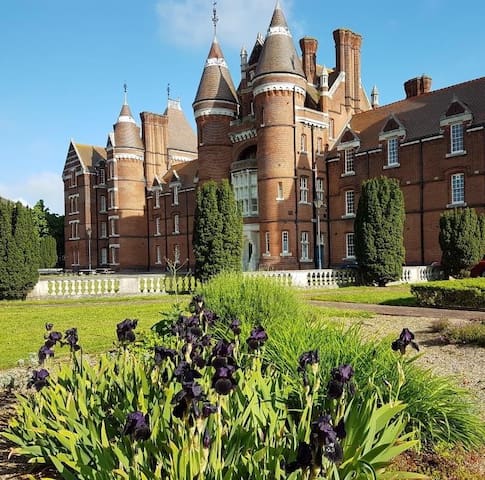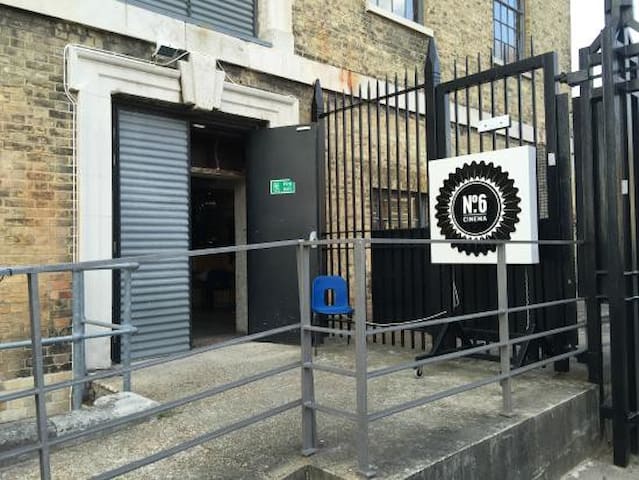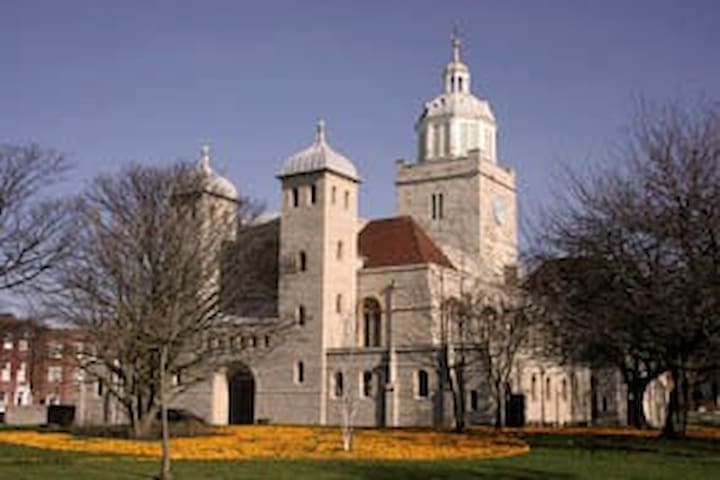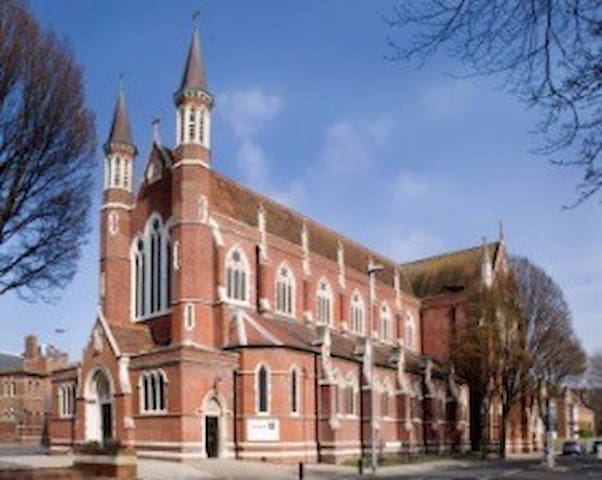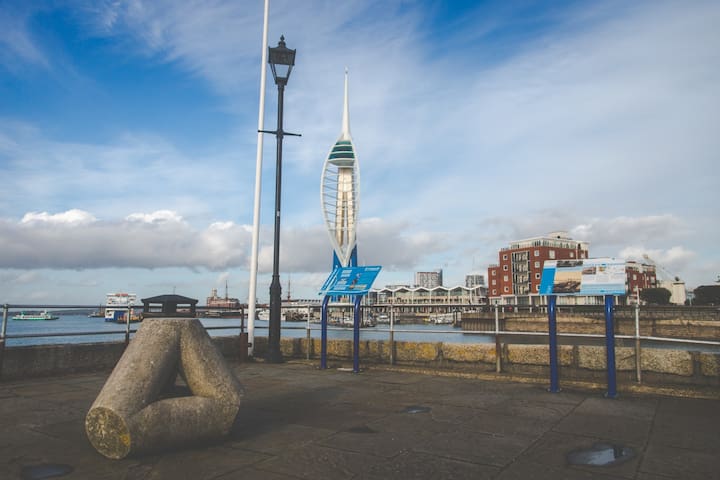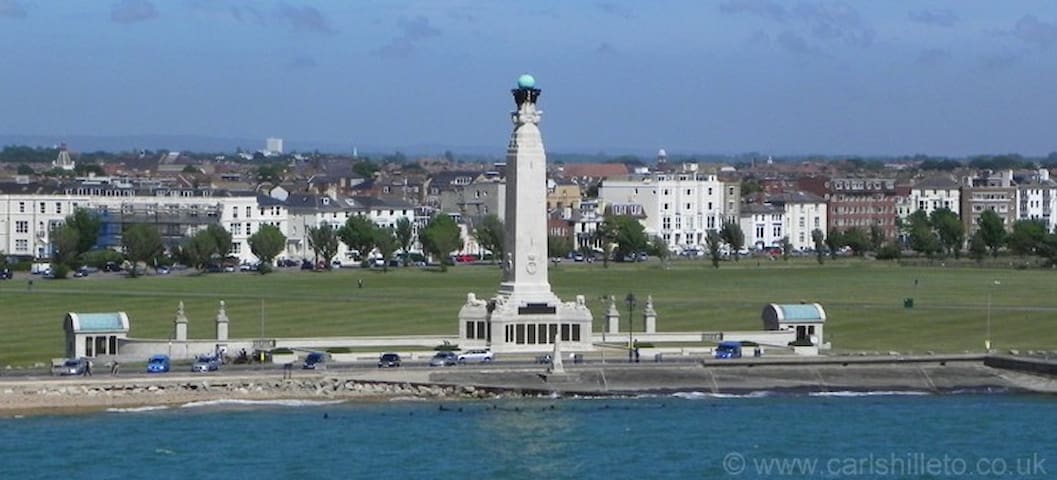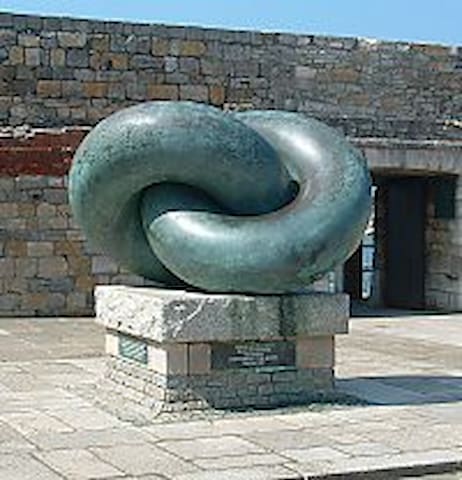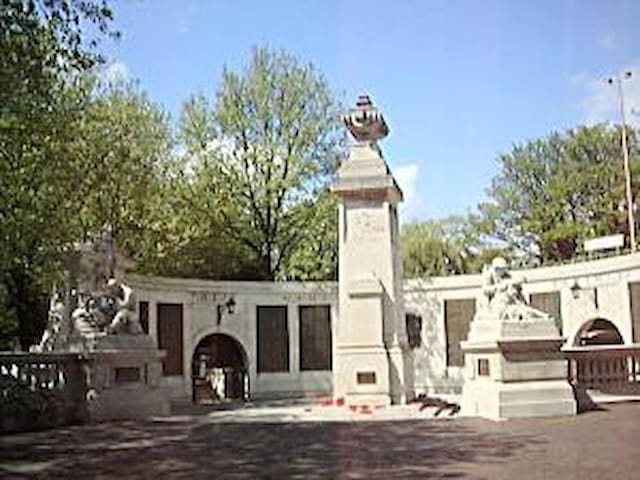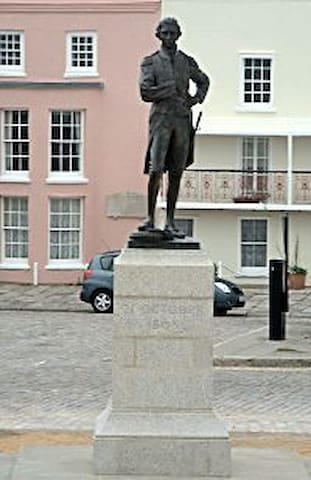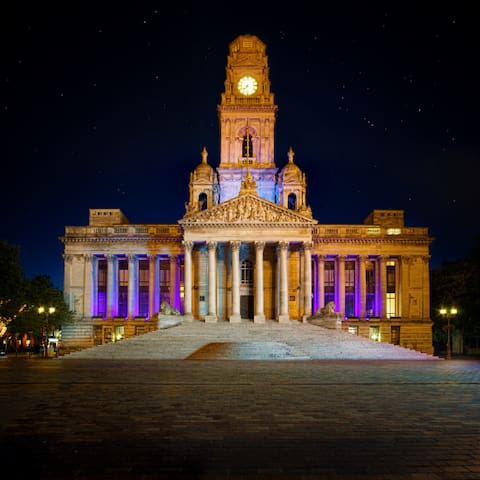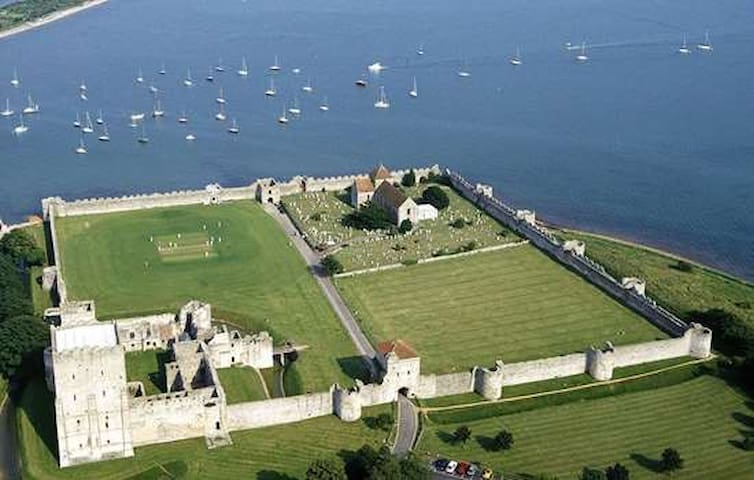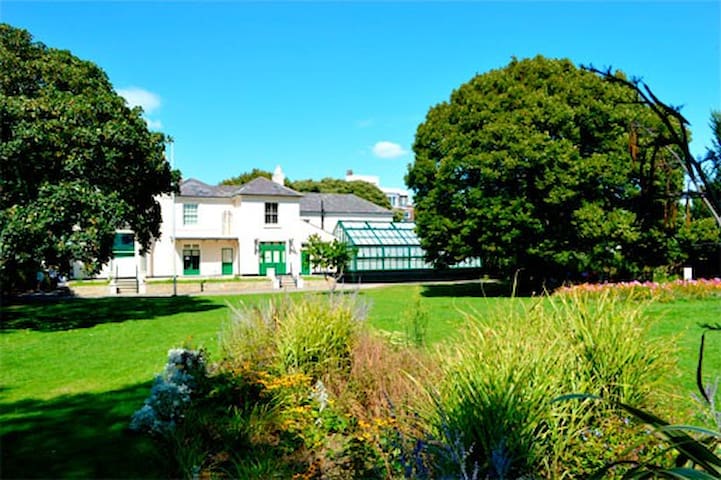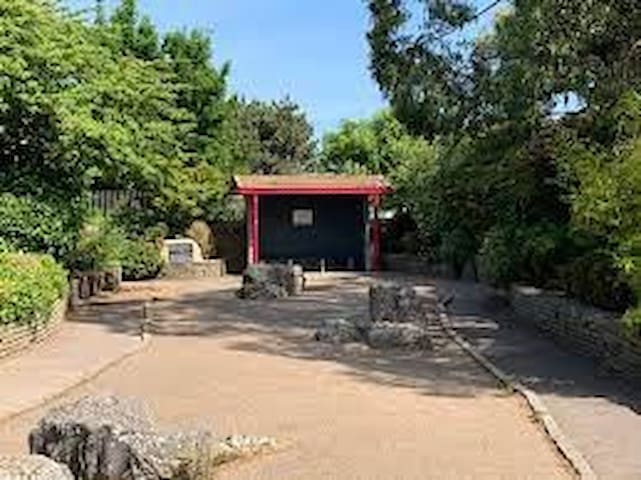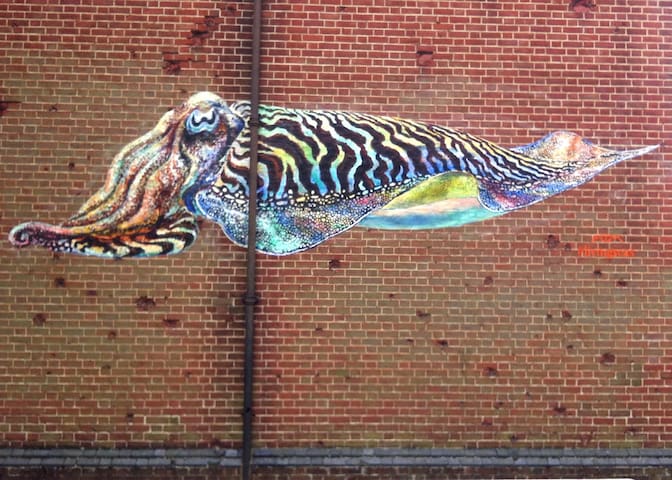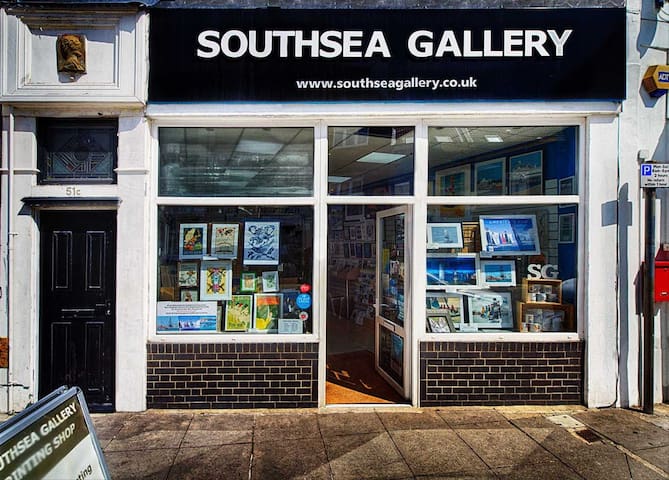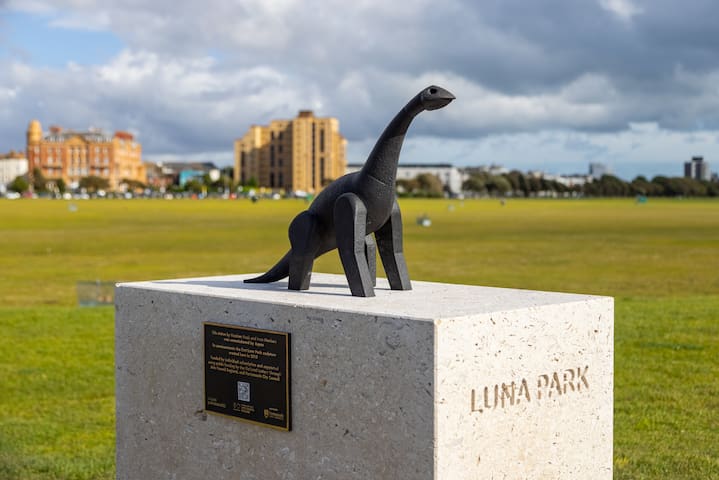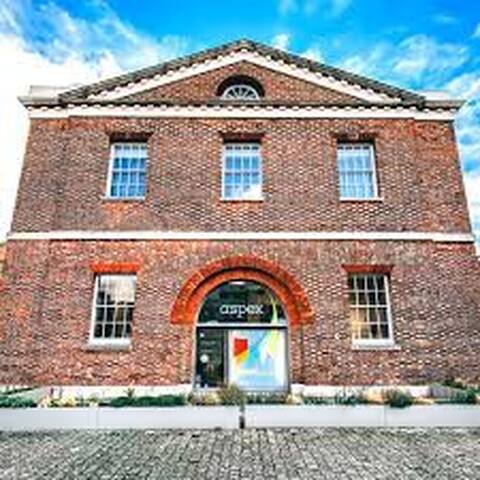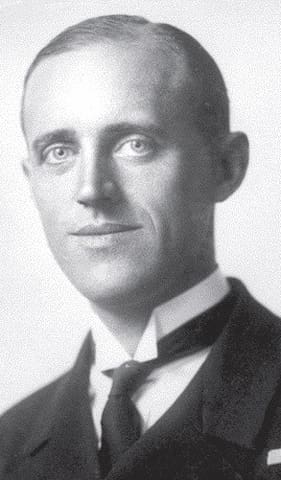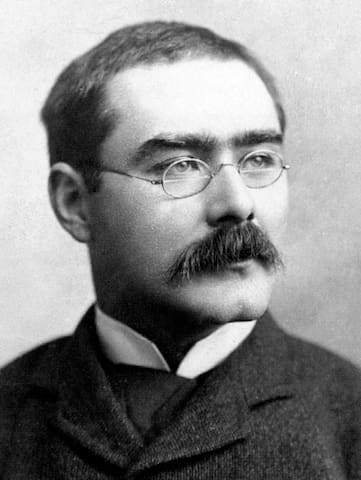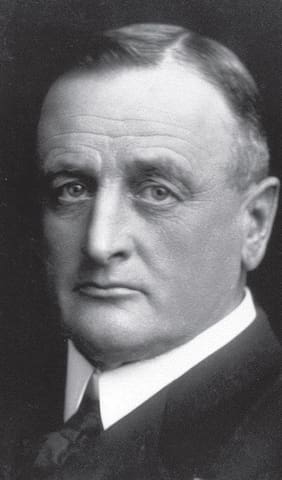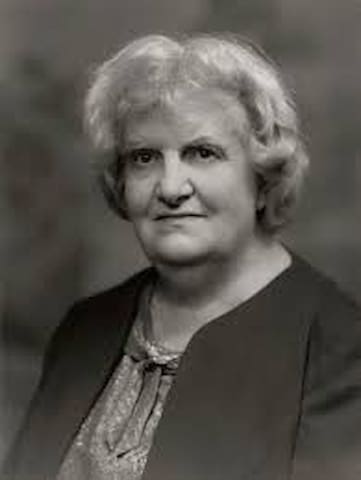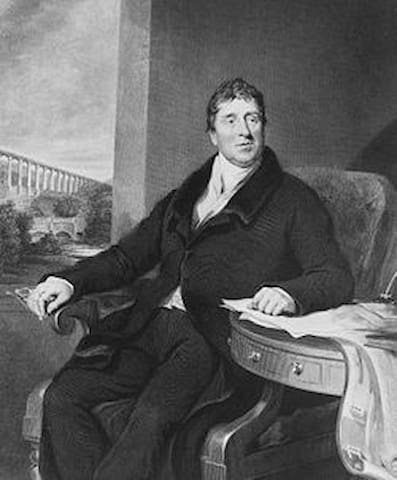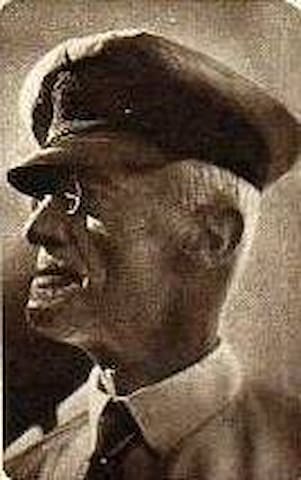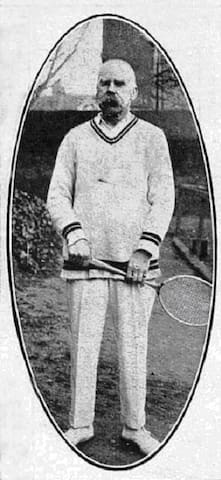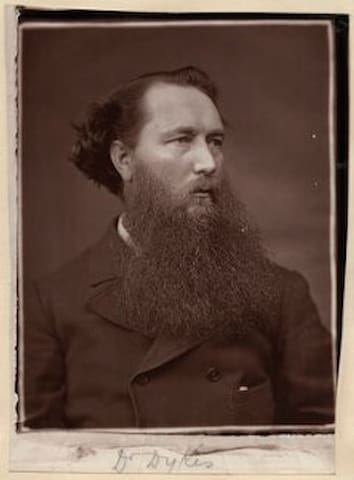Arts & Culture
Portsmouth Museum is the museum of and for the people of Portsmouth, featuring exciting and varied displays. The museum is free to enter, and open Tuesday to Sunday, 10am to 5pm.
In the Story of Portsmouth you can discover how life at home has changed over the generations, with reconstructions of a 17th century bedchamber, an 1871 dockyard worker's kitchen, a Victorian parlour, a 1930s kitchen and a 1950s living room. The story continues with 'Portsmouth at Play', on the beach, in the cinema, on the football field and dance floor. The Fine and Decorative Art Gallery features a wide range of material from the 17th century to the present day.
A Study in Sherlock explores the life of Sir Arthur Conan Doyle and the creation of his most famous character. It features a range of interactive displays, a ‘new’ Sherlock Holmes mystery, and narration by Stephen Fry, the Patron of the Collection. Come and experience the world of Sherlock Holmes and fine-tune your own powers of detection!
New for 2018: You Don't Know Sherlock Holmes, Yet... With much more of the Doyle archive now processed and available to explore, the entire ground floor of Portsmouth Museum has been given over to the Lancelyn Green bequest. See more about Holmes and the man who created him with this world-leading collection.
Football in the City is an exciting permanent gallery space devoted to the beautiful game. Currently on display are rare items such as both footballs from the 1939 and 2008 FA Cup Finals.
No Place Like Pompey considers the question of what makes Portsmouth unique. Is it one particular place, the city’s geography, its past or its people? The exhibition examines the fact that most of Portsmouth lies on an island, the city’s links with the dockyard and the Royal Navy, and the fortifications that made Portsmouth one of the most heavily defended areas in the country.
Magnifying Sherlock allows you to turn detective at Portsmouth Museum and follow the trail of the ultimate sleuth, Sherlock Holmes, and his creator Arthur Conan Doyle, who lived and worked in Portsmouth. Download this thrilling free experience as you follow in the footsteps of Sherlock on a navigational trail. Use your smartphone to stream the trail, or hire out an iPod from the City Museum reception desk. If you borrow an iPod you will be required to show photo ID such as a driver's licence.
As well as the above permanent exhibitions, a regularly changing programme of displays in the Temporary Exhibition Gallery ensures that there is always something to see or do.
Have you ever thought about how to cut plastic from your life? Portsmouth Museum has updated its 1930’s kitchen to show us how people lived without plastic back then, and there are some surprisingly good ideas for today. Staff members at the museum are using the 1930’s Highbury Estate kitchen to show how we can lead a more planet-friendly lifestyle. Returnable bottles, bars of soap, taking your own food and drink on outings, fruit straight into your basket, paper packaging and net covers for jugs are all easy ideas we can use now. The project is supported by Portsmouth’s One World Week group, which wants people to think about how we might learn from the past and change our lifestyles. We have to cut out plastic because its wasteful; it’s damaging our sea life (think Blue Planet); it can take centuries to biodegrade and we already have a landfill problem. Why not pop in, pick up the 'Living without plastic?' activity sheet and check out the 1930’s kitchen for yourself - see what differences you can spot!
30 lokale anbefaler
Portsmouth Museum and Art Gallery
Museum RoadPortsmouth Museum is the museum of and for the people of Portsmouth, featuring exciting and varied displays. The museum is free to enter, and open Tuesday to Sunday, 10am to 5pm.
In the Story of Portsmouth you can discover how life at home has changed over the generations, with reconstructions of a 17th century bedchamber, an 1871 dockyard worker's kitchen, a Victorian parlour, a 1930s kitchen and a 1950s living room. The story continues with 'Portsmouth at Play', on the beach, in the cinema, on the football field and dance floor. The Fine and Decorative Art Gallery features a wide range of material from the 17th century to the present day.
A Study in Sherlock explores the life of Sir Arthur Conan Doyle and the creation of his most famous character. It features a range of interactive displays, a ‘new’ Sherlock Holmes mystery, and narration by Stephen Fry, the Patron of the Collection. Come and experience the world of Sherlock Holmes and fine-tune your own powers of detection!
New for 2018: You Don't Know Sherlock Holmes, Yet... With much more of the Doyle archive now processed and available to explore, the entire ground floor of Portsmouth Museum has been given over to the Lancelyn Green bequest. See more about Holmes and the man who created him with this world-leading collection.
Football in the City is an exciting permanent gallery space devoted to the beautiful game. Currently on display are rare items such as both footballs from the 1939 and 2008 FA Cup Finals.
No Place Like Pompey considers the question of what makes Portsmouth unique. Is it one particular place, the city’s geography, its past or its people? The exhibition examines the fact that most of Portsmouth lies on an island, the city’s links with the dockyard and the Royal Navy, and the fortifications that made Portsmouth one of the most heavily defended areas in the country.
Magnifying Sherlock allows you to turn detective at Portsmouth Museum and follow the trail of the ultimate sleuth, Sherlock Holmes, and his creator Arthur Conan Doyle, who lived and worked in Portsmouth. Download this thrilling free experience as you follow in the footsteps of Sherlock on a navigational trail. Use your smartphone to stream the trail, or hire out an iPod from the City Museum reception desk. If you borrow an iPod you will be required to show photo ID such as a driver's licence.
As well as the above permanent exhibitions, a regularly changing programme of displays in the Temporary Exhibition Gallery ensures that there is always something to see or do.
Have you ever thought about how to cut plastic from your life? Portsmouth Museum has updated its 1930’s kitchen to show us how people lived without plastic back then, and there are some surprisingly good ideas for today. Staff members at the museum are using the 1930’s Highbury Estate kitchen to show how we can lead a more planet-friendly lifestyle. Returnable bottles, bars of soap, taking your own food and drink on outings, fruit straight into your basket, paper packaging and net covers for jugs are all easy ideas we can use now. The project is supported by Portsmouth’s One World Week group, which wants people to think about how we might learn from the past and change our lifestyles. We have to cut out plastic because its wasteful; it’s damaging our sea life (think Blue Planet); it can take centuries to biodegrade and we already have a landfill problem. Why not pop in, pick up the 'Living without plastic?' activity sheet and check out the 1930’s kitchen for yourself - see what differences you can spot!
No.6 Cinema is Portsmouth's premier independent cinema, showing some arthouse gems and forgotten classics alongside the big Hollywood blockbusters.
It's based in the world famous Portsmouth Historic Dockyard, which is also home many attractions including HMS Victory, The Mary Rose, HMS Warrior, National Museum of the Royal Navy and Action Stations.
Located in the Grade II listed Boathouse 6 (built in 1846), the 275-seat auditorium boasts one of the biggest screens on the South Coast!
Considered in Portsmouth as quite the hidden treasure, No.6 Cinema follows a policy of showing world cinema’s latest and greatest releases, whilst also mixing an eclectic blend of cult classics into our ever-refreshing programme. It's operated by Independent Cinema Portsmouth Ltd, a not-for-profit company limited by guarantee. They also have a well-stocked bar serving wine, beer, soft drinks and snacks, perfect for a quick catch up with friends before the film, or to take into the screening.
Tickets can be bought in advance online or on the evening of the performance from the box office. If the online tickets are sold out in advance of the screening a number of tickets are held back to sell to walk ups on the evening of the performance.
Regular screenings aside, No.6 Cinema also often runs special evenings in commemoration of certain movies, directors, or even seasonal genres, such as festive flicks at Christmastime or frightening horror films around Hallowe’en. Seats are not allocated, and are occupied on a first-come-first-serve basis.
no6cinema.co.uk/films
8 lokale anbefaler
No6 Cinema
No.6 Cinema is Portsmouth's premier independent cinema, showing some arthouse gems and forgotten classics alongside the big Hollywood blockbusters.
It's based in the world famous Portsmouth Historic Dockyard, which is also home many attractions including HMS Victory, The Mary Rose, HMS Warrior, National Museum of the Royal Navy and Action Stations.
Located in the Grade II listed Boathouse 6 (built in 1846), the 275-seat auditorium boasts one of the biggest screens on the South Coast!
Considered in Portsmouth as quite the hidden treasure, No.6 Cinema follows a policy of showing world cinema’s latest and greatest releases, whilst also mixing an eclectic blend of cult classics into our ever-refreshing programme. It's operated by Independent Cinema Portsmouth Ltd, a not-for-profit company limited by guarantee. They also have a well-stocked bar serving wine, beer, soft drinks and snacks, perfect for a quick catch up with friends before the film, or to take into the screening.
Tickets can be bought in advance online or on the evening of the performance from the box office. If the online tickets are sold out in advance of the screening a number of tickets are held back to sell to walk ups on the evening of the performance.
Regular screenings aside, No.6 Cinema also often runs special evenings in commemoration of certain movies, directors, or even seasonal genres, such as festive flicks at Christmastime or frightening horror films around Hallowe’en. Seats are not allocated, and are occupied on a first-come-first-serve basis.
no6cinema.co.uk/films
One of Victorian literature's most celebrated figures was born right here in Portsmouth. Take a look at Charles Dickens' first home, featuring numerous personal possessions and photographs. How did this home influence Charles Dickens and the immeasurably popular works he went on to create? What was life like for the Dickens family during the 1810s? Take a trip back in time at this historic home.
31 lokale anbefaler
Charles Dickens' Birthplace Museum
393 Old Commercial RdOne of Victorian literature's most celebrated figures was born right here in Portsmouth. Take a look at Charles Dickens' first home, featuring numerous personal possessions and photographs. How did this home influence Charles Dickens and the immeasurably popular works he went on to create? What was life like for the Dickens family during the 1810s? Take a trip back in time at this historic home.
The Cathedral Church of St Thomas of Canterbury, commonly known as Portsmouth Cathedral, is an English cathedral church. It is the cathedral of the Church of England Diocese of Portsmouth and is located in the centre of Old Portsmouth. It is the seat of the Bishop of Portsmouth.
The Anglican cathedral is one of the two cathedral churches in the city, the other being the Roman Catholic Cathedral of St John the Evangelist, Portsmouth which is located about one mile to the north.
13 lokale anbefaler
Portsmouth Cathedral
High StreetThe Cathedral Church of St Thomas of Canterbury, commonly known as Portsmouth Cathedral, is an English cathedral church. It is the cathedral of the Church of England Diocese of Portsmouth and is located in the centre of Old Portsmouth. It is the seat of the Bishop of Portsmouth.
The Anglican cathedral is one of the two cathedral churches in the city, the other being the Roman Catholic Cathedral of St John the Evangelist, Portsmouth which is located about one mile to the north.
The Cathedral Church of St John the Evangelist (also known as St John's Cathedral) is a Roman Catholic cathedral in Portsmouth, England. It is the mother church of the Portsmouth diocese and seat of the Bishop of Portsmouth, currently the Right Reverend Philip Egan. It was dedicated on 10 August 1882.
The cathedral is one of two cathedral churches in the city, the other being the Church of England Cathedral Church of St Thomas which is located about one mile to the south.
The cathedral was designed in Gothic Revival style by John Crawley in 1877-1881. Crawley died just as building started and his partner Joseph Hansom took over the project and modified the design, working on it until 1896. The church is built of Fareham Red Brick with Portland stone dressings. In 1900, John Cahill succeeded Vertue as Bishop of Portsmouth. Cahill completed the cathedral by adding the west front; the bell towers, designed by Canon Alexander Scoles, were added in 1906.
A memorial chapel dedicated to Our Lady Immaculate and St Edmund of Abingdon, patrons of the Diocese of Portsmouth, was created at the east end of the north aisle in memory of Bishop Vertue. A bronze statue of St John the Evangelist, by sculptor Philip Jackson, stands eight feet tall outside the Cathedral.
Most of the stained-glass windows sustained some bomb damage in 1941, especially those over the high altar. The round window in the south transept was the only one not damaged. An elaborate baldacchino surmounting the high altar was removed in the 1970 reordering. The last part to be built was St Patrick's Chapel in 1924.
St John's Cathedral
Bishop Crispian WayThe Cathedral Church of St John the Evangelist (also known as St John's Cathedral) is a Roman Catholic cathedral in Portsmouth, England. It is the mother church of the Portsmouth diocese and seat of the Bishop of Portsmouth, currently the Right Reverend Philip Egan. It was dedicated on 10 August 1882.
The cathedral is one of two cathedral churches in the city, the other being the Church of England Cathedral Church of St Thomas which is located about one mile to the south.
The cathedral was designed in Gothic Revival style by John Crawley in 1877-1881. Crawley died just as building started and his partner Joseph Hansom took over the project and modified the design, working on it until 1896. The church is built of Fareham Red Brick with Portland stone dressings. In 1900, John Cahill succeeded Vertue as Bishop of Portsmouth. Cahill completed the cathedral by adding the west front; the bell towers, designed by Canon Alexander Scoles, were added in 1906.
A memorial chapel dedicated to Our Lady Immaculate and St Edmund of Abingdon, patrons of the Diocese of Portsmouth, was created at the east end of the north aisle in memory of Bishop Vertue. A bronze statue of St John the Evangelist, by sculptor Philip Jackson, stands eight feet tall outside the Cathedral.
Most of the stained-glass windows sustained some bomb damage in 1941, especially those over the high altar. The round window in the south transept was the only one not damaged. An elaborate baldacchino surmounting the high altar was removed in the 1970 reordering. The last part to be built was St Patrick's Chapel in 1924.
Portsmouth Public Art: The Stone Markers of John Maine RA.
The Six (or 5) Stone Markers of John Maine line the Southsea shore.
John Maine’s work is maybe best described by Cass Sculpture Foundation:
“John Maine’s work is concerned with landscape, land forms, ancient sites, structures within nature, mathematical systems, solids, surface planes. He is particularly consumed with stone and works predominantly with Portland stone from Dorset where he lives. Drawing on traditional technique and echoing sculptures historical manipulation of stone Maine creates minimalist and formalist compositional works with recognisable architectural influences“.
For the City Art Project in 1974 John Maine created six different hollow tetrahedron sculptures carved from Whitbed Portland stone. Each stone measures 687mm x 687mm x 687mm . The blocks were initially sawn by The Stone Firms Ltd and the carving done at their then Portland works over a period of six months by John Maine with advice from their stone masons. Portsmouth Markers was then installed at different points along the Portsmouth & Southsea shoreline. These pieces were unlike many of the other works in the project as they were clearly designed and made to last, created from hard wearing stone and set permanently in at their different points.
The six markers form a sort of route along the seafront, starting off (going from west to east) at The Point in Old Portsmouth, overlooking Portsmouth Harbour. Back in 1974 this area would be difficult to recognise as it is now, with a working Camber, power station and no Spinnaker Tower.
The second marker is located at The Round Tower and The Hotwalls and at the time of installation this would have been the old barracks by the arches.
The third marker sits out at the southerly seaward point of the historic Spur Redoubt, the remains of a naval fort, from which Nelson left Portsmouth for the last time, and a fort that helped form the sea defences with Long Curtain and King’s Bastion. This is possibly the most striking (and most photographed) of all of the markers, with it standing proud in the sea view.
The next marker can be found up on the hill behind the Bandstand.
The last one can be found in Castle Field. This marker has at some point been moved from its original position up on the Outer Emplacement.
Each of the markers has their own distinct views through their tetrahedron form. They are often though to be of a similar design to depth markers that also line the coastal edge of the Southsea seafront highlighting underwater obstructions or low water.
ohn Maine talked about his ‘Portsmouth Markers’ sculpture project in a publication in 1986, reviewing his major projects up to that point, with the Portsmouth project the first on that list:
“I didn’t want to put up monumental sculptures, I wanted the sculptures to have an interaction with the site, to use them as a kind of punctuation…I’d been interested in the tetrahedron as a sculptural form for some time. It was a collision between what had been a formal interest – I’d done a lot of work previously based on tetrahedrons – at this point the tetrahedron took on a kind of external reference, at a time when the sculpture stopped being hermetic and started to be a sort of sensor in a place: something that was changed because of the place it was in and also changed the place that it was in.
The idea of having the pieces at some distance, often not visible from each other, was to restate the feeling I’d got from seeing military plans, the way fortresses are set out. There’s a ring of fortresses around Portsmouth and each has its own sphere of influence, its own arc of fire: when that sphere of influence wears out, there has to be another one to take on. I’d hoped that just at the point people were beginning to forget one they’d come in sight of another.
There were certain puns that came in to it unintentionally. Southsea Castle is one of Henry VIII’s string of fortresses – there is another fortress from that series on the coast next to Portland – in the exhibition area of that castle I saw plans of all the castles: they all had concentric walls because of the state of warfare at that time, and they’re often rose-shaped with a central circle, and quite a lot of them had one centre circle with three circles on either side, so almost like one of the pieces in plan, quite extraordinary, – it was a pun, really, because I’d already made the piece, but I’d always liked these fortresses too…you find things in life – in architecture, in this case military architecture – that were a reflection of something I’d liked, and been drawn to in the piece…”
The Missing Marker
It is open to argument if public art should complement & settle in to the environment or if it should be loud & proud, impossible to miss. John Maine’s markers have watched the world and the city change for almost 50 years and as such maybe they have disappeared from view in a way, as people walk by them day by day.
These clean, repeated and beautiful stone forms crafted by a hugely respected artist connect us with our city’s heritage but that by being weathered can age, can settle in to the city’s landscape & environment and subsequently become part of Portsmouth’s character, part of the heritage as the city moves forward. Few pieces of public art in Portsmouth can make that claim.
Hold up, I thought there were 6 markers? Yep, you are right, there were. At some point over the years a marker has disappeared. The story goes that one of them was damaged by builders during some development work along the seafront and sadly it was lost. The exact original site of this missing marker is difficult to nail down but from photography taken when they were first placed it would be what is now the entrance to Blue Reef. When installed originally the Blue Reef building had not yet been built so maybe it was damaged at some point during the construction.
The Point
3B Bath SquarePortsmouth Public Art: The Stone Markers of John Maine RA.
The Six (or 5) Stone Markers of John Maine line the Southsea shore.
John Maine’s work is maybe best described by Cass Sculpture Foundation:
“John Maine’s work is concerned with landscape, land forms, ancient sites, structures within nature, mathematical systems, solids, surface planes. He is particularly consumed with stone and works predominantly with Portland stone from Dorset where he lives. Drawing on traditional technique and echoing sculptures historical manipulation of stone Maine creates minimalist and formalist compositional works with recognisable architectural influences“.
For the City Art Project in 1974 John Maine created six different hollow tetrahedron sculptures carved from Whitbed Portland stone. Each stone measures 687mm x 687mm x 687mm . The blocks were initially sawn by The Stone Firms Ltd and the carving done at their then Portland works over a period of six months by John Maine with advice from their stone masons. Portsmouth Markers was then installed at different points along the Portsmouth & Southsea shoreline. These pieces were unlike many of the other works in the project as they were clearly designed and made to last, created from hard wearing stone and set permanently in at their different points.
The six markers form a sort of route along the seafront, starting off (going from west to east) at The Point in Old Portsmouth, overlooking Portsmouth Harbour. Back in 1974 this area would be difficult to recognise as it is now, with a working Camber, power station and no Spinnaker Tower.
The second marker is located at The Round Tower and The Hotwalls and at the time of installation this would have been the old barracks by the arches.
The third marker sits out at the southerly seaward point of the historic Spur Redoubt, the remains of a naval fort, from which Nelson left Portsmouth for the last time, and a fort that helped form the sea defences with Long Curtain and King’s Bastion. This is possibly the most striking (and most photographed) of all of the markers, with it standing proud in the sea view.
The next marker can be found up on the hill behind the Bandstand.
The last one can be found in Castle Field. This marker has at some point been moved from its original position up on the Outer Emplacement.
Each of the markers has their own distinct views through their tetrahedron form. They are often though to be of a similar design to depth markers that also line the coastal edge of the Southsea seafront highlighting underwater obstructions or low water.
ohn Maine talked about his ‘Portsmouth Markers’ sculpture project in a publication in 1986, reviewing his major projects up to that point, with the Portsmouth project the first on that list:
“I didn’t want to put up monumental sculptures, I wanted the sculptures to have an interaction with the site, to use them as a kind of punctuation…I’d been interested in the tetrahedron as a sculptural form for some time. It was a collision between what had been a formal interest – I’d done a lot of work previously based on tetrahedrons – at this point the tetrahedron took on a kind of external reference, at a time when the sculpture stopped being hermetic and started to be a sort of sensor in a place: something that was changed because of the place it was in and also changed the place that it was in.
The idea of having the pieces at some distance, often not visible from each other, was to restate the feeling I’d got from seeing military plans, the way fortresses are set out. There’s a ring of fortresses around Portsmouth and each has its own sphere of influence, its own arc of fire: when that sphere of influence wears out, there has to be another one to take on. I’d hoped that just at the point people were beginning to forget one they’d come in sight of another.
There were certain puns that came in to it unintentionally. Southsea Castle is one of Henry VIII’s string of fortresses – there is another fortress from that series on the coast next to Portland – in the exhibition area of that castle I saw plans of all the castles: they all had concentric walls because of the state of warfare at that time, and they’re often rose-shaped with a central circle, and quite a lot of them had one centre circle with three circles on either side, so almost like one of the pieces in plan, quite extraordinary, – it was a pun, really, because I’d already made the piece, but I’d always liked these fortresses too…you find things in life – in architecture, in this case military architecture – that were a reflection of something I’d liked, and been drawn to in the piece…”
The Missing Marker
It is open to argument if public art should complement & settle in to the environment or if it should be loud & proud, impossible to miss. John Maine’s markers have watched the world and the city change for almost 50 years and as such maybe they have disappeared from view in a way, as people walk by them day by day.
These clean, repeated and beautiful stone forms crafted by a hugely respected artist connect us with our city’s heritage but that by being weathered can age, can settle in to the city’s landscape & environment and subsequently become part of Portsmouth’s character, part of the heritage as the city moves forward. Few pieces of public art in Portsmouth can make that claim.
Hold up, I thought there were 6 markers? Yep, you are right, there were. At some point over the years a marker has disappeared. The story goes that one of them was damaged by builders during some development work along the seafront and sadly it was lost. The exact original site of this missing marker is difficult to nail down but from photography taken when they were first placed it would be what is now the entrance to Blue Reef. When installed originally the Blue Reef building had not yet been built so maybe it was damaged at some point during the construction.
Standing on Southsea Common overlooking the promenade in Portsmouth, Hampshire, is the Portsmouth Naval Memorial. It commemorates nearly 10,000 naval personnel of the First World War and almost 15,000 of the Second World War who were lost or buried at sea.
More than 45,000 men and women lost their lives while serving with the Royal Navy during the First World War. After the Armistice, the naval authorities and the Commonwealth War Graves Commission were determined to find an appropriate way to commemorate naval personnel who had no grave.
Portsmouth Naval Memorial is one of three naval memorials in the UK. The others are at Plymouth and Chatham. All three memorials were designed by Sir Robert Lorimer with sculpture by Henry Poole. Each design is the same with an obelisk of Portland stone surmounted by a copper sphere. The memorial commemorates nearly 10,000 sailors of the First World War and almost 15,000 of the Second World War. The Second World War extension was designed by Sir Edward Maufe with additional sculpture by Charles Wheeler, William McMillan and Esmond Burton. It was unveiled on 15 October 1924 by Prince Albert, the future King George VI. The extension was unveiled by the Queen Elizabeth, the Queen Mother, on 29 April 1953.
Portsmouth Naval Memorial
Clarence EsplanadeStanding on Southsea Common overlooking the promenade in Portsmouth, Hampshire, is the Portsmouth Naval Memorial. It commemorates nearly 10,000 naval personnel of the First World War and almost 15,000 of the Second World War who were lost or buried at sea.
More than 45,000 men and women lost their lives while serving with the Royal Navy during the First World War. After the Armistice, the naval authorities and the Commonwealth War Graves Commission were determined to find an appropriate way to commemorate naval personnel who had no grave.
Portsmouth Naval Memorial is one of three naval memorials in the UK. The others are at Plymouth and Chatham. All three memorials were designed by Sir Robert Lorimer with sculpture by Henry Poole. Each design is the same with an obelisk of Portland stone surmounted by a copper sphere. The memorial commemorates nearly 10,000 sailors of the First World War and almost 15,000 of the Second World War. The Second World War extension was designed by Sir Edward Maufe with additional sculpture by Charles Wheeler, William McMillan and Esmond Burton. It was unveiled on 15 October 1924 by Prince Albert, the future King George VI. The extension was unveiled by the Queen Elizabeth, the Queen Mother, on 29 April 1953.
The Square Tower is one of the oldest parts of the fortifications of Portsmouth, England. It is a Grade I listed building.
A tower was built in 1494 as part of the fortifications and served as a home to the Governor of Portsmouth.
In 1584, it was converted to a gunpowder store, the governor having moved to a residence next to the Garrison Church. At the time of the royalist surrender of Portsmouth at the end of the Siege of Portsmouth during the English Civil War 1200 barrels of gunpowder were stored in the tower; the royalists were able to use the threat of detonating the store as a bargaining chip during the negotiations leading up to the surrender.
From 1676 Pierson's Wharf, at the northern tip of The Point, was leased to the Board of Ordnance to serve as a gun wharf (where naval cannons and other items were stored for easy loading on to ships, which could moor nearby). This led to gunpowder barrels routinely being rolled the length of the cobbled roads of The Point, between the tower and the wharf, inevitably leading to a certain amount of spillage. A wharf, known as the powder bridge, was built with access directly from the tower, allowing the barrels to be loaded onto ships moored alongside the wharf. In the 1690s an additional magazine (the 'New Magazine') was built on a triangular promontory on the east side of The Camber. All these locations were alongside built-up areas, and concerns about the hazards of an explosion led to calls for Portsmouth's gunpowder stores to be relocated.
In 1779, the gunpowder having been relocated to Priddy's Hard, the Square Tower was given to the Victualling Board to serve as a Royal Navy meat store, remaining as such until 1850, when this function was moved to the new Victualling Yard complex at Gosport.
In 1823, the Board of Admiralty installed a semaphore tower on the roof, the first link in a signalling chain running between the Royal Dockyard and The Admiralty in London. Following the introduction of the electrical telegraph, the semaphore tower was demolished in 1848.
The tower was manned during both World Wars. It was purchased by Portsmouth City Council in 1958-1960.
In a niche on the east wall is a bust of Charles I by Hubrecht le Sueur. The original was presented to the city by the King to commemorate his safe arrival from his trip to France and Spain in 1623. There is the following inscription below the Royal coat of arms: "After his travels through all France into Spain and having passed very many dangers both by sea and land he arrived here the 5th day of October 1623". The bust now on display is a 20th century copy, the original is in the city museum.
6 lokale anbefaler
Square Tower
Broad StreetThe Square Tower is one of the oldest parts of the fortifications of Portsmouth, England. It is a Grade I listed building.
A tower was built in 1494 as part of the fortifications and served as a home to the Governor of Portsmouth.
In 1584, it was converted to a gunpowder store, the governor having moved to a residence next to the Garrison Church. At the time of the royalist surrender of Portsmouth at the end of the Siege of Portsmouth during the English Civil War 1200 barrels of gunpowder were stored in the tower; the royalists were able to use the threat of detonating the store as a bargaining chip during the negotiations leading up to the surrender.
From 1676 Pierson's Wharf, at the northern tip of The Point, was leased to the Board of Ordnance to serve as a gun wharf (where naval cannons and other items were stored for easy loading on to ships, which could moor nearby). This led to gunpowder barrels routinely being rolled the length of the cobbled roads of The Point, between the tower and the wharf, inevitably leading to a certain amount of spillage. A wharf, known as the powder bridge, was built with access directly from the tower, allowing the barrels to be loaded onto ships moored alongside the wharf. In the 1690s an additional magazine (the 'New Magazine') was built on a triangular promontory on the east side of The Camber. All these locations were alongside built-up areas, and concerns about the hazards of an explosion led to calls for Portsmouth's gunpowder stores to be relocated.
In 1779, the gunpowder having been relocated to Priddy's Hard, the Square Tower was given to the Victualling Board to serve as a Royal Navy meat store, remaining as such until 1850, when this function was moved to the new Victualling Yard complex at Gosport.
In 1823, the Board of Admiralty installed a semaphore tower on the roof, the first link in a signalling chain running between the Royal Dockyard and The Admiralty in London. Following the introduction of the electrical telegraph, the semaphore tower was demolished in 1848.
The tower was manned during both World Wars. It was purchased by Portsmouth City Council in 1958-1960.
In a niche on the east wall is a bust of Charles I by Hubrecht le Sueur. The original was presented to the city by the King to commemorate his safe arrival from his trip to France and Spain in 1623. There is the following inscription below the Royal coat of arms: "After his travels through all France into Spain and having passed very many dangers both by sea and land he arrived here the 5th day of October 1623". The bust now on display is a 20th century copy, the original is in the city museum.
The First Fleet of settlers sailed to Botany Bay, Australia, on 13 May 1787 from Spithead, Portsmouth and anchored in Sydney Cove on 26th January, 1788. The Fleet was led by Captain Arthur Phillip RN. The "Bonds of Friendship" sculpture is located near the Sally Port at Portsmouth Harbour through which Captain Phillip and many of his fellow voyagers passed on their way to embark. It symbolizes the closeness of the ties that were forged between Portsmouth and Sydney as a result of the the voyage of the First Fleet and represents a links in a chain joining both cities It was unveiled by The Queen on the 11th July 1980. Today it is a reminder of Portsmouth's past links with Australia and is a token of friendship between the two countries.
A twin monument was unveiled at Circular Quay, Sydney, Australia in 1980 as part of the Bicentenery Celebrations. It now resides in the Jesse Street Gardens, just near Macquarie Place, Sydney CBD, Australia. The granite block above the plinth of the Australian companion sculpture was quarried at Dartmoor, England and donated to the City of Sydney by the City of Portsmouth as a return gift from a similar block of granite from N.S.W. given to them by the City.
The actual sculpture, "Bonds of Friendship" was the work of the sculptor, John Robinson. It is a chain with only two links, locked tightly together, representing the gift of trust between friends. Artist’s Statement : “These are the feelings I wanted to express with a symbol. I found it by creating the strongest chain possible … a chain with only two links, locked so tightly together it is inseparable, thus able to withstand the pressures of life.”
6 lokale anbefaler
Square Tower
Broad StreetThe First Fleet of settlers sailed to Botany Bay, Australia, on 13 May 1787 from Spithead, Portsmouth and anchored in Sydney Cove on 26th January, 1788. The Fleet was led by Captain Arthur Phillip RN. The "Bonds of Friendship" sculpture is located near the Sally Port at Portsmouth Harbour through which Captain Phillip and many of his fellow voyagers passed on their way to embark. It symbolizes the closeness of the ties that were forged between Portsmouth and Sydney as a result of the the voyage of the First Fleet and represents a links in a chain joining both cities It was unveiled by The Queen on the 11th July 1980. Today it is a reminder of Portsmouth's past links with Australia and is a token of friendship between the two countries.
A twin monument was unveiled at Circular Quay, Sydney, Australia in 1980 as part of the Bicentenery Celebrations. It now resides in the Jesse Street Gardens, just near Macquarie Place, Sydney CBD, Australia. The granite block above the plinth of the Australian companion sculpture was quarried at Dartmoor, England and donated to the City of Sydney by the City of Portsmouth as a return gift from a similar block of granite from N.S.W. given to them by the City.
The actual sculpture, "Bonds of Friendship" was the work of the sculptor, John Robinson. It is a chain with only two links, locked tightly together, representing the gift of trust between friends. Artist’s Statement : “These are the feelings I wanted to express with a symbol. I found it by creating the strongest chain possible … a chain with only two links, locked so tightly together it is inseparable, thus able to withstand the pressures of life.”
Long Curtain, King's Bastion and Spur Redoubt.
The strategic importance of Portsmouth grew rapidly after the middle of the seventeenth century and, in response to this, the earlier Elizabethan defences were updated and improved by the Dutch military engineer Sir Bernard de Gomme. His design included remodelling the existing ramparts, reconstructing the bastions, widening the moats, building the first ravelin and outworks designed to withstand prolonged sieges. Although defences of this type are common in mainland Europe, Portsmouth was the only British town of this date where they were adopted. This monument is of outstanding interest as the only surviving extant length of the ramparts and moat which enclosed Portsmouth. The Spur Redoubt forms an integral part of this defensive arrangement.
Details
This monument includes a stretch of curtain wall known as the Long Curtain, a length of contemporary moat, a substantial bastion called King's Bastion (or Wimbledon's Bastion as it was known in the 17th century) and the associated Spur Redoubt. The curtain wall is part of the 16th century Portsmouth town defences, later reconstructed by de Gomme. It survives as an earthen rampart with inclined inner face, flat top and stone outward face rising almost vertically from the moat. Above this is a brick parapet bordering a walk-way along the outward side of the rampart. The King's Bastion is four-sided, with two short flanks and two longer diagonal sides coming to an apex. The sides are stone-walled, with a low brick parapet wall and the top is banked and grassed. The curtain wall and bastion were re-utilised during the Second World War and traces of the artillery concrete bases survive. The Spur Redoubt was built in 1680 by de Gomme. Essentially the Spur Redoubt is a small fort of triangular plan, detached from the main fortifications, and was designed to strengthen the line at what was then considered a possibly vulnerable point. Access to the Spur Redoubt was through a brick lined sally port under the curtain wall and a light wooden bridge across the moat. Lord Nelson passed through this sally port in 1805 on his last departure from England. Following periods of dereliction and rebuilding the upper parts of the Spur were removed and the lower levels covered in 1934 when the public promenade was created. In 1988 an excavation and restoration programme revealed standing masonry up to 2m high on average and this has now been consolidated. Excluded from the scheduling are the path surfaces, lamp posts, two timber bridges, park benches, iron railings and a 24 pound cannon, although the ground beneath these features is included.
King's Bastion
Long Curtain, King's Bastion and Spur Redoubt.
The strategic importance of Portsmouth grew rapidly after the middle of the seventeenth century and, in response to this, the earlier Elizabethan defences were updated and improved by the Dutch military engineer Sir Bernard de Gomme. His design included remodelling the existing ramparts, reconstructing the bastions, widening the moats, building the first ravelin and outworks designed to withstand prolonged sieges. Although defences of this type are common in mainland Europe, Portsmouth was the only British town of this date where they were adopted. This monument is of outstanding interest as the only surviving extant length of the ramparts and moat which enclosed Portsmouth. The Spur Redoubt forms an integral part of this defensive arrangement.
Details
This monument includes a stretch of curtain wall known as the Long Curtain, a length of contemporary moat, a substantial bastion called King's Bastion (or Wimbledon's Bastion as it was known in the 17th century) and the associated Spur Redoubt. The curtain wall is part of the 16th century Portsmouth town defences, later reconstructed by de Gomme. It survives as an earthen rampart with inclined inner face, flat top and stone outward face rising almost vertically from the moat. Above this is a brick parapet bordering a walk-way along the outward side of the rampart. The King's Bastion is four-sided, with two short flanks and two longer diagonal sides coming to an apex. The sides are stone-walled, with a low brick parapet wall and the top is banked and grassed. The curtain wall and bastion were re-utilised during the Second World War and traces of the artillery concrete bases survive. The Spur Redoubt was built in 1680 by de Gomme. Essentially the Spur Redoubt is a small fort of triangular plan, detached from the main fortifications, and was designed to strengthen the line at what was then considered a possibly vulnerable point. Access to the Spur Redoubt was through a brick lined sally port under the curtain wall and a light wooden bridge across the moat. Lord Nelson passed through this sally port in 1805 on his last departure from England. Following periods of dereliction and rebuilding the upper parts of the Spur were removed and the lower levels covered in 1934 when the public promenade was created. In 1988 an excavation and restoration programme revealed standing masonry up to 2m high on average and this has now been consolidated. Excluded from the scheduling are the path surfaces, lamp posts, two timber bridges, park benches, iron railings and a 24 pound cannon, although the ground beneath these features is included.
The Cenotaph in the Guildhall Square comprises of two memorials - one to the dead of World War I and one to the dead of World War II. It is accessible at all times.
The World War I Memorial includes two sculptures of machine gunners by Charles Sargeant Jagger (1885-1934), an artist who was a veteran of WW1 and a recipient of the Military Cross. He was wounded at Gallipoli, and again, near-fatally during the Western Front campaign of 1918.
PEACE OR CONFLICT MEMORIAL. This white stone plaque on the pedestal to the North Gunner was paid for by Portsmouth City Council and unveiled on 6 November 2003 by Mrs Madeleine Dunn who heads the Portsmouth War Widows.
THE WORLD WAR I MEMORIAL
Preparations for the construction of the Cenotaph began almost as soon as the Great War ended, but it was not until 1920 that invitations to subscribe to the cost were made. A list of all who donated money and the amounts they gave is held at the Central Library in Guildhall Square.
At the same time, local people were asked to nominate the service persons whose names should appear on the memorial, the criteria being 'That the man was born in Portsmouth, (or) that he resided in Portsmouth when the war began, (or) that his home was in Portsmouth when the war began'. Great stress was laid on the concept that 'Not a single name should be omitted', however a perusal of the local parishioners memorials shows a considerable discrepancy on this matter.
THE WORLD WAR II MEMORIAL
For 60 years following the end of World War II the only memorial to the men and women who lost their lives was a low stone wall at the rear of the Cenotaph with the words 'IN MEMORY OF THOSE WHO LOST THEIR LIVES IN WORLD WAR II 1939 - 1945' inscribed upon it.
On 8th November 2005 a new WWII memorial was unveiled by Princess Alexandra. That this memorial should exist at all is almost wholly down to the dogged determination of Jean Louth whose father Harry Short had died on the beaches of Dunkirk. It was Jean Louth with the help of organisations such as the Normandy Veterans Association and the Portsmouth South Branch of the Royal British Legion who lobbied for funds to raise this memorial. This though was only the first phase as Jean was determined that the names of those who died should be included on the memorial and it took a further eight years to raise the funds necessary to inscribe and raise the twelve panels of names.
Portsmouth WW1 Cenotaph
The Cenotaph in the Guildhall Square comprises of two memorials - one to the dead of World War I and one to the dead of World War II. It is accessible at all times.
The World War I Memorial includes two sculptures of machine gunners by Charles Sargeant Jagger (1885-1934), an artist who was a veteran of WW1 and a recipient of the Military Cross. He was wounded at Gallipoli, and again, near-fatally during the Western Front campaign of 1918.
PEACE OR CONFLICT MEMORIAL. This white stone plaque on the pedestal to the North Gunner was paid for by Portsmouth City Council and unveiled on 6 November 2003 by Mrs Madeleine Dunn who heads the Portsmouth War Widows.
THE WORLD WAR I MEMORIAL
Preparations for the construction of the Cenotaph began almost as soon as the Great War ended, but it was not until 1920 that invitations to subscribe to the cost were made. A list of all who donated money and the amounts they gave is held at the Central Library in Guildhall Square.
At the same time, local people were asked to nominate the service persons whose names should appear on the memorial, the criteria being 'That the man was born in Portsmouth, (or) that he resided in Portsmouth when the war began, (or) that his home was in Portsmouth when the war began'. Great stress was laid on the concept that 'Not a single name should be omitted', however a perusal of the local parishioners memorials shows a considerable discrepancy on this matter.
THE WORLD WAR II MEMORIAL
For 60 years following the end of World War II the only memorial to the men and women who lost their lives was a low stone wall at the rear of the Cenotaph with the words 'IN MEMORY OF THOSE WHO LOST THEIR LIVES IN WORLD WAR II 1939 - 1945' inscribed upon it.
On 8th November 2005 a new WWII memorial was unveiled by Princess Alexandra. That this memorial should exist at all is almost wholly down to the dogged determination of Jean Louth whose father Harry Short had died on the beaches of Dunkirk. It was Jean Louth with the help of organisations such as the Normandy Veterans Association and the Portsmouth South Branch of the Royal British Legion who lobbied for funds to raise this memorial. This though was only the first phase as Jean was determined that the names of those who died should be included on the memorial and it took a further eight years to raise the funds necessary to inscribe and raise the twelve panels of names.
The statue stands on a plinth approximately 1570mms square in Grand Parade, adjacent to the slope leading up to the Saluting Platform.
The siting of the statue of Lord Nelson has been the subject of some controversy for many years. He was originally placed in Pembroke Gardens (see photo 3) so that he looked towards that part of Southsea Beach where it is believed that he embarked for his flagship HMS Victory in September 1805. Unfortunately he was placed some 200yds from the beach and over the years his "view" of it became increasingly obstructed by the construction of a funfair. Eventually he just seemed isolated and it was proposed to move the statue to a more appropriate position.
Many locations were suggested but the City Council settled for a site in Grand Parade, a few yards from the sloping path leading up to the Saluting Platform. This decision has satisfied few people as Nelson is now in such a position that he could only "see" the sea if he stood on tiptoes, thereby defeating the very object of moving the statue.
Whilst discussing the new location for the statue, it is said that regard was had for the route that Nelson took from the George Hotel, where he had breakfasted that September morning in 1805, to the beach from where he was ferried to the Victory. The route itself had been the subject of much debate over the years but it is now broadly agreed that it began when he left from the rear of the George Hotel onto Penny Street and turned right. He then turned left and walked along what is now Pembroke Road until he reached the fortifications; at that point he turned right and followed the line of the earthworks to a tunnel under the Long Curtain. The tunnel led out onto a drawbridge across the moat, the far end of which was Spur Redoubt. A narrow passage on the Redoubt led onto the beach where his barge and several hundred well-wishers were waiting.
The new location for the statue is several hundred yards from any point on Nelson's last walk.
It should also be noted that when in its original position, a lectern supporting a plaque had been sited a hundred feet in front of the statue. This has also been moved to Grand Parade, though sited somewhat closer to the statue. The text on the plaque has been altered such that the sentence "HE PASSED OVER THE SPOT WHERE THE STATUE STANDS 14TH SEPT 1805 IT FACES THE PLACE ON THE BEACH WHERE HE EMBARKED FOR H.M.S. VICTORY." has been omitted and a further paragraph added. It reads "THE STATUE WAS ORIGINALLY LOCATED AT PEMBROKE GARDENS IN SOUTHSEA. IT WAS MOVED TO THIS MORE PROMINENT AND HISTORIC LOCATION IN OCTOBER 2005 TO MARK THE BICENTENARY OF THE BATTLE OF TRAFALGAR."
Horatio Nelson Statue
14 Grand ParadeThe statue stands on a plinth approximately 1570mms square in Grand Parade, adjacent to the slope leading up to the Saluting Platform.
The siting of the statue of Lord Nelson has been the subject of some controversy for many years. He was originally placed in Pembroke Gardens (see photo 3) so that he looked towards that part of Southsea Beach where it is believed that he embarked for his flagship HMS Victory in September 1805. Unfortunately he was placed some 200yds from the beach and over the years his "view" of it became increasingly obstructed by the construction of a funfair. Eventually he just seemed isolated and it was proposed to move the statue to a more appropriate position.
Many locations were suggested but the City Council settled for a site in Grand Parade, a few yards from the sloping path leading up to the Saluting Platform. This decision has satisfied few people as Nelson is now in such a position that he could only "see" the sea if he stood on tiptoes, thereby defeating the very object of moving the statue.
Whilst discussing the new location for the statue, it is said that regard was had for the route that Nelson took from the George Hotel, where he had breakfasted that September morning in 1805, to the beach from where he was ferried to the Victory. The route itself had been the subject of much debate over the years but it is now broadly agreed that it began when he left from the rear of the George Hotel onto Penny Street and turned right. He then turned left and walked along what is now Pembroke Road until he reached the fortifications; at that point he turned right and followed the line of the earthworks to a tunnel under the Long Curtain. The tunnel led out onto a drawbridge across the moat, the far end of which was Spur Redoubt. A narrow passage on the Redoubt led onto the beach where his barge and several hundred well-wishers were waiting.
The new location for the statue is several hundred yards from any point on Nelson's last walk.
It should also be noted that when in its original position, a lectern supporting a plaque had been sited a hundred feet in front of the statue. This has also been moved to Grand Parade, though sited somewhat closer to the statue. The text on the plaque has been altered such that the sentence "HE PASSED OVER THE SPOT WHERE THE STATUE STANDS 14TH SEPT 1805 IT FACES THE PLACE ON THE BEACH WHERE HE EMBARKED FOR H.M.S. VICTORY." has been omitted and a further paragraph added. It reads "THE STATUE WAS ORIGINALLY LOCATED AT PEMBROKE GARDENS IN SOUTHSEA. IT WAS MOVED TO THIS MORE PROMINENT AND HISTORIC LOCATION IN OCTOBER 2005 TO MARK THE BICENTENARY OF THE BATTLE OF TRAFALGAR."
The Strand city map mural in Southsea, Portsmouth, Hampshire was originally painted back in 1998 and was unveiled by the local mayor which subsequently won the best landscape award from the Portsmouth society and raised local trade by 30%, employed local artists, trained others, offered free workshops on lower the level creating an amazing pride and community spirit that has lasted over 20 years.
At a cost of only £8,000 total including £5,000 from the arts council and £2,500 from Portsmouth City Council, this has become one of the best value for tax payer’s money the city has ever seen. This has also grown to become one of the most well-known public art murals on the south coast of England.
After 5 years the render at the lower level of the mural started to come down in patches, as the first 7ft of the wall was not rendered in 1997 as it was in sound condition there became problems when the overflow pipe from the middle flat was leaking for over one year and subsidence in the area. In 2008 we had an on-site meeting with Portsmouth Housing Association/ First Wessex and now Vivid the owners of the building and we all concluded the render needed to come down due to subsidence.
We secured some money from the neighbourhood funds in 2003 to fix the problem after the housing Association re-rendered the patch. We also run free art workshops for the local community and tourists walking past and reached over 100 people all painting flowers, butterflies and insects on the ground level.
One of the most unique parts of the strand mural is that it can be added to year after year, we are still getting requests to add people, business premises, company vans, people riding bikes or on the beach. In theory, we could be painting more and more detail on there every year for 3-4 months throughout the summer for the next 20-30 years. Creating the most detailed public art mural in the UK.
The Strand City Map Mural
86 Clarendon RdThe Strand city map mural in Southsea, Portsmouth, Hampshire was originally painted back in 1998 and was unveiled by the local mayor which subsequently won the best landscape award from the Portsmouth society and raised local trade by 30%, employed local artists, trained others, offered free workshops on lower the level creating an amazing pride and community spirit that has lasted over 20 years.
At a cost of only £8,000 total including £5,000 from the arts council and £2,500 from Portsmouth City Council, this has become one of the best value for tax payer’s money the city has ever seen. This has also grown to become one of the most well-known public art murals on the south coast of England.
After 5 years the render at the lower level of the mural started to come down in patches, as the first 7ft of the wall was not rendered in 1997 as it was in sound condition there became problems when the overflow pipe from the middle flat was leaking for over one year and subsidence in the area. In 2008 we had an on-site meeting with Portsmouth Housing Association/ First Wessex and now Vivid the owners of the building and we all concluded the render needed to come down due to subsidence.
We secured some money from the neighbourhood funds in 2003 to fix the problem after the housing Association re-rendered the patch. We also run free art workshops for the local community and tourists walking past and reached over 100 people all painting flowers, butterflies and insects on the ground level.
One of the most unique parts of the strand mural is that it can be added to year after year, we are still getting requests to add people, business premises, company vans, people riding bikes or on the beach. In theory, we could be painting more and more detail on there every year for 3-4 months throughout the summer for the next 20-30 years. Creating the most detailed public art mural in the UK.
https://www.kingsportsmouth.co.uk/whats-on/
The Kings Theatre was designed by the architect Frank Matcham. It opened on 30 September 1907. It is operated by the Kings Theatre Trust Ltd. The building was designated a Grade II* listed building in 1976.
Much of the backstage area is still fully manual, allowing it to retain the tag of a traditional hemp house, though powered flying bars have now been installed to allow large-scale productions.
In 1974, director Ken Russell filmed the Pinball Wizard sequence of the rock opera Tommy at the theatre, featuring The Who and Elton John on the stage.
Many one night touring shows come through the Kings Theatre, from ballet to rock music, through drama to children's shows. One of the biggest draws is the Christmas Pantomime. The Kings Theatre is well known in Hampshire for its very traditional family pantomimes.
51 lokale anbefaler
Kings Theatre station
https://www.kingsportsmouth.co.uk/whats-on/
The Kings Theatre was designed by the architect Frank Matcham. It opened on 30 September 1907. It is operated by the Kings Theatre Trust Ltd. The building was designated a Grade II* listed building in 1976.
Much of the backstage area is still fully manual, allowing it to retain the tag of a traditional hemp house, though powered flying bars have now been installed to allow large-scale productions.
In 1974, director Ken Russell filmed the Pinball Wizard sequence of the rock opera Tommy at the theatre, featuring The Who and Elton John on the stage.
Many one night touring shows come through the Kings Theatre, from ballet to rock music, through drama to children's shows. One of the biggest draws is the Christmas Pantomime. The Kings Theatre is well known in Hampshire for its very traditional family pantomimes.
https://www.newtheatreroyal.com/whats-on/
The New Theatre Royal is a Victorian Grade II* listed theatre in the heart of Portsmouth, England, with a capacity of 667. The theatre building was constructed in 1854 as Landport Hall. It was converted to a theatre two years later. It was rebuilt in 1884 by Charles J. Phipps and again in 1900 by Frank Matcham.
Most of the famous performers of the late nineteenth and early twentieth centuries appeared at the Theatre Royal. Sir Henry Irving and his leading lady and mistress, Ellen Terry, appeared many times both individually and together. Sarah Bernhardt performed there on several occasions, including her legendary appearances in later life when in a wheelchair. She left her signature on the wall of the dressing rooms (it was retrieved after the fire in 1972). Marie Lloyd was also a regular. Laurel and Hardy appeared before fame in Hollywood and Oliver Hardy chose the theatre as the venue for his birthday party in 1954. Similarly Morecombe and Wise were among many twentieth-century variety stars who appeared early in their career. Irving died on tour in a Bradford hotel in 1905 but his last complete set of performances was completed two weeks earlier at the Theatre Royal Portsmouth. Ellen Terry was appearing there the week he died. During some of performances his private secretary and theatre manager, Abraham ('Bram') Stoker - author of his biography and of the classic Gothic novel Dracula - worked in the offices backstage.
There is no clear evidence of when or why people began to refer to the theatre as 'New'. From 1856 to 1976 the theatre was official the Theatre Royal. At some point the 'New' was informally added.
13 lokale anbefaler
New Theatre Royal
20-24 Guildhall Walkhttps://www.newtheatreroyal.com/whats-on/
The New Theatre Royal is a Victorian Grade II* listed theatre in the heart of Portsmouth, England, with a capacity of 667. The theatre building was constructed in 1854 as Landport Hall. It was converted to a theatre two years later. It was rebuilt in 1884 by Charles J. Phipps and again in 1900 by Frank Matcham.
Most of the famous performers of the late nineteenth and early twentieth centuries appeared at the Theatre Royal. Sir Henry Irving and his leading lady and mistress, Ellen Terry, appeared many times both individually and together. Sarah Bernhardt performed there on several occasions, including her legendary appearances in later life when in a wheelchair. She left her signature on the wall of the dressing rooms (it was retrieved after the fire in 1972). Marie Lloyd was also a regular. Laurel and Hardy appeared before fame in Hollywood and Oliver Hardy chose the theatre as the venue for his birthday party in 1954. Similarly Morecombe and Wise were among many twentieth-century variety stars who appeared early in their career. Irving died on tour in a Bradford hotel in 1905 but his last complete set of performances was completed two weeks earlier at the Theatre Royal Portsmouth. Ellen Terry was appearing there the week he died. During some of performances his private secretary and theatre manager, Abraham ('Bram') Stoker - author of his biography and of the classic Gothic novel Dracula - worked in the offices backstage.
There is no clear evidence of when or why people began to refer to the theatre as 'New'. From 1856 to 1976 the theatre was official the Theatre Royal. At some point the 'New' was informally added.
Portsmouth Guildhall is a multi-use venue in the centre of Portsmouth, UK, located on a pedestrian square close to the Portsmouth and Southsea railway station. Constructed in 1890 and originally used by the local council, the building was known as Portsmouth Town Hall until 1926. It was heavily damaged by bombing during the Second World War and largely rebuilt during the 1950s. Today it operates as a concert, wedding and conference venue.
The building was designed in the neo-classical style by architect William Hill, who had previously designed the visually similar Bolton Town Hall. Local architect Charles Bevis, in partnership with Hill, directed the construction. Hill died before the building was completed and Bevis added to the design.
When completed in 1890, the building became the civic town hall. On 21 April 1926 Portsmouth was raised to the status of a city and the town hall was simultaneously renamed the Guildhall.
On 10 January 1941, during the Second World War, it was hit by enemy incendiary bombs. The resultant fire gutted the building, completely destroying the interior and roof. Just the outer walls and tower remained standing, and those were fire-damaged. The Guildhall was rebuilt after the war at a cost of £1.5 million, using war compensation funds. The interior was altered from the original and the external style is missing much of its original detail, especially the dome above the clock and the finials atop the balustrades around the roof. Elizabeth II re-opened the building in a ceremony on 8 June 1959.
There are five bells in its bell tower, collectively nicknamed The Pompey Chimes, as they inspired the football chant of the same name. The largest of the five bells, Victoria is named after Queen Victoria and is inscribed with her name, and chimes on the hour. The four quarter bells chime at 15, 30 and 45 minutes past the hour and play the Westminster Quarters, just before Victoria tolls on the hour.
The Pompey Chimes fell silent in 2003 when the bell tower was found to be in need of restoration from the corrosive nature of sea salt in the Portsmouth air. The work was carried out by Smith of Derby Group, the restoration project finishing in time for Queen Elizabeth's visit to Portsmouth in 2009 to mark the 65th anniversary of the D-Day landings.
The four quarter bells were to have been officially named Nelson, Victory, John Pounds and Harry Redknapp in a 2008 public poll by Portsmouth City Council in 2008. The official naming was stalled due to the high popularity of internet votes for Harry Redknapp's name from unregistered anonymous voters. Redknapp, the former Portsmouth Football Club manager had suddenly departed the club for Tottenham Hotspur F.C. shortly before bell name voting commenced, which had left a wide range of emotions among many Portsmouth Football Club fans and city residents. Foul play, possibly from rival football supporters was suspected by Portsmouth City Council, who had organised the vote, and the four quarter bells have remained unnamed.
15 lokale anbefaler
Portsmouth Guildhall
Portsmouth Guildhall is a multi-use venue in the centre of Portsmouth, UK, located on a pedestrian square close to the Portsmouth and Southsea railway station. Constructed in 1890 and originally used by the local council, the building was known as Portsmouth Town Hall until 1926. It was heavily damaged by bombing during the Second World War and largely rebuilt during the 1950s. Today it operates as a concert, wedding and conference venue.
The building was designed in the neo-classical style by architect William Hill, who had previously designed the visually similar Bolton Town Hall. Local architect Charles Bevis, in partnership with Hill, directed the construction. Hill died before the building was completed and Bevis added to the design.
When completed in 1890, the building became the civic town hall. On 21 April 1926 Portsmouth was raised to the status of a city and the town hall was simultaneously renamed the Guildhall.
On 10 January 1941, during the Second World War, it was hit by enemy incendiary bombs. The resultant fire gutted the building, completely destroying the interior and roof. Just the outer walls and tower remained standing, and those were fire-damaged. The Guildhall was rebuilt after the war at a cost of £1.5 million, using war compensation funds. The interior was altered from the original and the external style is missing much of its original detail, especially the dome above the clock and the finials atop the balustrades around the roof. Elizabeth II re-opened the building in a ceremony on 8 June 1959.
There are five bells in its bell tower, collectively nicknamed The Pompey Chimes, as they inspired the football chant of the same name. The largest of the five bells, Victoria is named after Queen Victoria and is inscribed with her name, and chimes on the hour. The four quarter bells chime at 15, 30 and 45 minutes past the hour and play the Westminster Quarters, just before Victoria tolls on the hour.
The Pompey Chimes fell silent in 2003 when the bell tower was found to be in need of restoration from the corrosive nature of sea salt in the Portsmouth air. The work was carried out by Smith of Derby Group, the restoration project finishing in time for Queen Elizabeth's visit to Portsmouth in 2009 to mark the 65th anniversary of the D-Day landings.
The four quarter bells were to have been officially named Nelson, Victory, John Pounds and Harry Redknapp in a 2008 public poll by Portsmouth City Council in 2008. The official naming was stalled due to the high popularity of internet votes for Harry Redknapp's name from unregistered anonymous voters. Redknapp, the former Portsmouth Football Club manager had suddenly departed the club for Tottenham Hotspur F.C. shortly before bell name voting commenced, which had left a wide range of emotions among many Portsmouth Football Club fans and city residents. Foul play, possibly from rival football supporters was suspected by Portsmouth City Council, who had organised the vote, and the four quarter bells have remained unnamed.
"Looking for a fun family day out? Visit Portchester Castle in Hampshire, South East England. It provides the perfect setting for a relaxed, fun, historic day out. The castle’s commanding location has made it a major factor in the Solent's defences for hundreds of years. The most impressive and best-preserved of the Roman 'Saxon Shore' forts, Portchester Castle was originally built in the late 3rd century. An exhibition in the keep interprets the history of the castle and Portchester village, and displays finds excavated on site. The inclusive audio tour explains life in the castle over the centuries."
Located at the northern end of Portsmouth Harbour, Portchester Castle is a medieval castle built within a former Roman fort. It is It is designated as a World Heritage site. Grounds have a church with tea room selling good priced homemade cakes. Great place to take children, with plenty of space to run around in the safety of the walls of the castle. Walk along the coast and relax taking in the views of the sea. There is a paid car park but it is small and can get filled up quickly.
39 lokale anbefaler
Portchester Castle
Church Lane"Looking for a fun family day out? Visit Portchester Castle in Hampshire, South East England. It provides the perfect setting for a relaxed, fun, historic day out. The castle’s commanding location has made it a major factor in the Solent's defences for hundreds of years. The most impressive and best-preserved of the Roman 'Saxon Shore' forts, Portchester Castle was originally built in the late 3rd century. An exhibition in the keep interprets the history of the castle and Portchester village, and displays finds excavated on site. The inclusive audio tour explains life in the castle over the centuries."
Located at the northern end of Portsmouth Harbour, Portchester Castle is a medieval castle built within a former Roman fort. It is It is designated as a World Heritage site. Grounds have a church with tea room selling good priced homemade cakes. Great place to take children, with plenty of space to run around in the safety of the walls of the castle. Walk along the coast and relax taking in the views of the sea. There is a paid car park but it is small and can get filled up quickly.
Anti Tank Blocks along Eastney Beach are now protected!
It has now been confirmed by the Secretary of State via English Heritage that all the 280 WW II Anti-Tank Blocks right along Eastney Beach, including those on beach in front of the Fraser Range buildings, are Listed Grade II being of special interest under the Planning (Listed Buildings and Conservation Areas) Act 1990.
What does this mean? Well, it means that the blocks cannot be movedp, destroyed, tampered with at all without the written express permission of the Secretary of State – indeed, to do so would be an illegal act!
Ferry Road
Ferry RoadAnti Tank Blocks along Eastney Beach are now protected!
It has now been confirmed by the Secretary of State via English Heritage that all the 280 WW II Anti-Tank Blocks right along Eastney Beach, including those on beach in front of the Fraser Range buildings, are Listed Grade II being of special interest under the Planning (Listed Buildings and Conservation Areas) Act 1990.
What does this mean? Well, it means that the blocks cannot be movedp, destroyed, tampered with at all without the written express permission of the Secretary of State – indeed, to do so would be an illegal act!
https://hotwallsstudios.co.uk/
A collection of artists' studios where you can see the artists at work and buy artwork and gifts.
Over the centuries, Portsmouth’s defences often fell into disrepair, only being repaired when there was a new invasion threat. When the Round Tower was first built, Portsmouth’s defences were mainly constructed from earth and timber. As guns grew more powerful, the Round Tower’s defences were not sufficient. In the 1680s, Eighteen Gun Battery was built next to it, stretching towards the Square Tower. This was part of a major revision of Portsmouth’s defences on the orders of King Charles II, carried out by the Dutch fortress engineer Bernard de Gomme. Around 1850, the whole area between the fortifications and Broad Street was walled off to become Point Battery and Barracks, providing living quarters for the soldiers who manned these guns. Today the outline of the soldiers’ barracks rooms is marked out with bricks on the ground.
The Round Tower and the other nearby fortifications were purchased by Portsmouth City Council the 1960s. In recent years they have undergone extensive renovation and development work to turn the old, disused arches into modern, thriving art spaces. The Hotwalls Studios now comprises 13 spaces for up and coming designers, makers and artists to establish themselves and reach new audiences. The Round Tower itself is also used intermittently as an art gallery, with plans in place for it to host events more frequently.
On top of all this there is a brand new cafe on site, The Canteen. Here you can take in stunning views of the Solent with a coffee and gluten-free snack. The top of the Round Tower is open throughout the year for visitors to enjoy great sea and city views.
"Game Over" is Portsmouth’s first and only video game cafe...
In an awesome basement setting you can book sessions in 2 hour blocks, and game to your hearts content. We have every single game and console that you can imagine, from the Vectrex to the Game Cube, from Playstation 1 to Pong on the Binatone TV Master IV.
19 lokale anbefaler
The Hotwalls Studios
Broad Streethttps://hotwallsstudios.co.uk/
A collection of artists' studios where you can see the artists at work and buy artwork and gifts.
Over the centuries, Portsmouth’s defences often fell into disrepair, only being repaired when there was a new invasion threat. When the Round Tower was first built, Portsmouth’s defences were mainly constructed from earth and timber. As guns grew more powerful, the Round Tower’s defences were not sufficient. In the 1680s, Eighteen Gun Battery was built next to it, stretching towards the Square Tower. This was part of a major revision of Portsmouth’s defences on the orders of King Charles II, carried out by the Dutch fortress engineer Bernard de Gomme. Around 1850, the whole area between the fortifications and Broad Street was walled off to become Point Battery and Barracks, providing living quarters for the soldiers who manned these guns. Today the outline of the soldiers’ barracks rooms is marked out with bricks on the ground.
The Round Tower and the other nearby fortifications were purchased by Portsmouth City Council the 1960s. In recent years they have undergone extensive renovation and development work to turn the old, disused arches into modern, thriving art spaces. The Hotwalls Studios now comprises 13 spaces for up and coming designers, makers and artists to establish themselves and reach new audiences. The Round Tower itself is also used intermittently as an art gallery, with plans in place for it to host events more frequently.
On top of all this there is a brand new cafe on site, The Canteen. Here you can take in stunning views of the Solent with a coffee and gluten-free snack. The top of the Round Tower is open throughout the year for visitors to enjoy great sea and city views.
"Game Over" is Portsmouth’s first and only video game cafe...
In an awesome basement setting you can book sessions in 2 hour blocks, and game to your hearts content. We have every single game and console that you can imagine, from the Vectrex to the Game Cube, from Playstation 1 to Pong on the Binatone TV Master IV.
Southsea Castle was one in a series of forts constructed for King Henry VIII in what was the most ambitious scheme of coastal defence since Roman times.
The castle was built in great haste in 1544, prompted by Henry VIII’s fears of a French attack on Portsmouth. It was said to have been designed by the King himself, incorporating the latest continental ideas on the layout of artillery forts. It was not long finished when, on 18 July 1545, a French invasion fleet did indeed approach Portsmouth after landing on the Isle of Wight. Henry VIII mobilised his fleet and was at Southsea Castle for the Battle of the Solent the next day. However, it was to be a dark day for the king; his much-loved flagship – The Mary Rose – sank during battle.
The castle was to be an active military base for over 400 years, where life had its fair share of ups and downs. In 1627, for example, the keep was gutted by fire. Then in 1642, at the outset of the English Civil War, the Royalist commander was almost too drunk to surrender when a large Parliamentary force surrounded the castle. The Parliamentarian soldiers clambered over the walls, and the garrison surrendered with no loss of life.
Later there was to be loss of life, when seventeen men, women and children died in 1759 after an accidental explosion blew up a large part of the castle. The building became so dilapidated that it was nearly demolished. However, in 1814 Southsea Castle was completely renovated to accommodate extra guns and a larger garrison in time of war.
The castle’s key position guarding the entrance to Portsmouth Harbour meant that whenever danger threatened it was right in the front line. Even when it was used as a military prison during Victorian times, its guns still had to be ready for action. Not until 1960 was the castle finally withdrawn from active service and purchased by Portsmouth City Council.
Today it’s a popular visitor attraction – providing a much more welcoming environment to anyone on the approach. It houses displays telling of the castle’s history, as well as a shop, top-quality restaurant and even a much-loved microbrewery. Though it still features some historic cannons, today the ramparts are used instead for enjoying the view out to sea.
76 lokale anbefaler
Southsea Slot
Clarence EsplanadeSouthsea Castle was one in a series of forts constructed for King Henry VIII in what was the most ambitious scheme of coastal defence since Roman times.
The castle was built in great haste in 1544, prompted by Henry VIII’s fears of a French attack on Portsmouth. It was said to have been designed by the King himself, incorporating the latest continental ideas on the layout of artillery forts. It was not long finished when, on 18 July 1545, a French invasion fleet did indeed approach Portsmouth after landing on the Isle of Wight. Henry VIII mobilised his fleet and was at Southsea Castle for the Battle of the Solent the next day. However, it was to be a dark day for the king; his much-loved flagship – The Mary Rose – sank during battle.
The castle was to be an active military base for over 400 years, where life had its fair share of ups and downs. In 1627, for example, the keep was gutted by fire. Then in 1642, at the outset of the English Civil War, the Royalist commander was almost too drunk to surrender when a large Parliamentary force surrounded the castle. The Parliamentarian soldiers clambered over the walls, and the garrison surrendered with no loss of life.
Later there was to be loss of life, when seventeen men, women and children died in 1759 after an accidental explosion blew up a large part of the castle. The building became so dilapidated that it was nearly demolished. However, in 1814 Southsea Castle was completely renovated to accommodate extra guns and a larger garrison in time of war.
The castle’s key position guarding the entrance to Portsmouth Harbour meant that whenever danger threatened it was right in the front line. Even when it was used as a military prison during Victorian times, its guns still had to be ready for action. Not until 1960 was the castle finally withdrawn from active service and purchased by Portsmouth City Council.
Today it’s a popular visitor attraction – providing a much more welcoming environment to anyone on the approach. It houses displays telling of the castle’s history, as well as a shop, top-quality restaurant and even a much-loved microbrewery. Though it still features some historic cannons, today the ramparts are used instead for enjoying the view out to sea.
Portsmouth is a very special place for wildlife in Britain. It has many different habitats in a very small area, and at Portsmouth Natural History Museum you can explore them all.
Displays introduce the wildlife of the area - past and present.
Following extensive redevelopment, The Butterfly House is now open! We have a huge array of neo-tropical butterflies, including swallowtails, morphos and owl butterflies. There is also the puparium where pupae are kept during their metamorphosis. The butterflies aren't the only thing to see, though, as there is a host of plant life within the greenhouse, including orchids, jasmine, banana, lemon trees and lantana. These aren't there to look pretty, however, but provide much-needed shade for the butterflies and food for the caterpillars. They've even become places for the happy butterflies to lay their eggs. Please note: butterfly season is May - September.
13 lokale anbefaler
Cumberland House Natural History Museum
Eastern ParadePortsmouth is a very special place for wildlife in Britain. It has many different habitats in a very small area, and at Portsmouth Natural History Museum you can explore them all.
Displays introduce the wildlife of the area - past and present.
Following extensive redevelopment, The Butterfly House is now open! We have a huge array of neo-tropical butterflies, including swallowtails, morphos and owl butterflies. There is also the puparium where pupae are kept during their metamorphosis. The butterflies aren't the only thing to see, though, as there is a host of plant life within the greenhouse, including orchids, jasmine, banana, lemon trees and lantana. These aren't there to look pretty, however, but provide much-needed shade for the butterflies and food for the caterpillars. They've even become places for the happy butterflies to lay their eggs. Please note: butterfly season is May - September.
A derelict ballroom disused for 40 years has been transformed by an immersive art project.
The Queen's Hotel-owned ballroom in Southsea, Portsmouth, was in disrepair when it was identified by street artist My Dog Sighs for an exhibition.
The artist, who goes only by his first name Paul, said the aim was to show how beauty can be created out of lost and forgotten spaces.
He funded the art installation through crowdfunding and remortgaging his home.
My Dog Sighs has become well known for a series of characters and realistic eye murals that have appeared on buildings in the Hampshire seaside resort and around the world.
"I stumbled across this incredible empty building and as soon as I stepped in I realised it was the opportunity of a lifetime, an empty building no-one has been into for 40 years was just the fantastic place to build my own world," he said.
He said the project, which took 18 months to complete, included a series of sculptures of ghost-like beings that he called the Quiet Little Voices.
An exhibition will open at the site on Osborne Road between 16 July and 1 August 2021.
18 Osborne Rd
18 Osborne RoadA derelict ballroom disused for 40 years has been transformed by an immersive art project.
The Queen's Hotel-owned ballroom in Southsea, Portsmouth, was in disrepair when it was identified by street artist My Dog Sighs for an exhibition.
The artist, who goes only by his first name Paul, said the aim was to show how beauty can be created out of lost and forgotten spaces.
He funded the art installation through crowdfunding and remortgaging his home.
My Dog Sighs has become well known for a series of characters and realistic eye murals that have appeared on buildings in the Hampshire seaside resort and around the world.
"I stumbled across this incredible empty building and as soon as I stepped in I realised it was the opportunity of a lifetime, an empty building no-one has been into for 40 years was just the fantastic place to build my own world," he said.
He said the project, which took 18 months to complete, included a series of sculptures of ghost-like beings that he called the Quiet Little Voices.
An exhibition will open at the site on Osborne Road between 16 July and 1 August 2021.
THE PORTSMOUTH MUSIC EXPERIENCE EXHIBITION
Gallery reflecting on the Portsmouth music scene and history of the Guildhall. Free Entry.
https://portsmouthguildhall.org.uk/whats-on/exhibition/the-portsmouth-music-experience-exhibition/
http://www.portsmouthmusicexperience.org.uk/
15 lokale anbefaler
Portsmouth Guildhall
THE PORTSMOUTH MUSIC EXPERIENCE EXHIBITION
Gallery reflecting on the Portsmouth music scene and history of the Guildhall. Free Entry.
https://portsmouthguildhall.org.uk/whats-on/exhibition/the-portsmouth-music-experience-exhibition/
http://www.portsmouthmusicexperience.org.uk/
The Japanese Garden.
http://www.memorialsinportsmouth.co.uk/southsea/japanese_garden.htm
The Japanese Zen Garden, created in the shelter of the old Lumps Fort walls, has a small ornamental bridge and oriental reeds.There is a stone monument from the ruins of the 16th century Tanabe Castle, donated by Portsmouth's Japanese sister city of Maizuru. The garden is a typical Japanese Dry Garden with a Summer House and was constructed in 2000 to celebrate the twinning of the two cities.
Japanese Garden
The Japanese Garden.
http://www.memorialsinportsmouth.co.uk/southsea/japanese_garden.htm
The Japanese Zen Garden, created in the shelter of the old Lumps Fort walls, has a small ornamental bridge and oriental reeds.There is a stone monument from the ruins of the 16th century Tanabe Castle, donated by Portsmouth's Japanese sister city of Maizuru. The garden is a typical Japanese Dry Garden with a Summer House and was constructed in 2000 to celebrate the twinning of the two cities.
THE LARGE CUTTLEFISH MURAL at The Edwardian Records Office beside Portsmouth Museum.
Painted for the Wildlife Trusts’ National Marine Week. It’s on a wall next to Portsmouth Museum, on the main road to the Isle of Wight ferry, and so reaches an audience of thousands. It also forms part of the Hampshire and Isle of Wight Wildlife Trust’s campaign to protect the Solent #livingseas.
National Marine Week celebrates all the wonderful creatures that live in the seas around the UK, many of them little-known and mysterious.
Cuttlefish have three hearts and an ability to change their colour and skin texture to merge with their surroundings. They also perform spectacular light and colour displays across their bodies.
They migrate to lay their eggs in the seagrass meadows of the warmer waters around the UK. They thrive in the Solent, the stretch of sea between mainland England and the Isle of Wight.
The seagrass is a very important and now quite rare habitat. It nurtures myriad species, from young fish to sea horses, crabs, shrimps, sea squirts and sponges.
30 lokale anbefaler
Portsmouth Museum and Art Gallery
Museum RoadTHE LARGE CUTTLEFISH MURAL at The Edwardian Records Office beside Portsmouth Museum.
Painted for the Wildlife Trusts’ National Marine Week. It’s on a wall next to Portsmouth Museum, on the main road to the Isle of Wight ferry, and so reaches an audience of thousands. It also forms part of the Hampshire and Isle of Wight Wildlife Trust’s campaign to protect the Solent #livingseas.
National Marine Week celebrates all the wonderful creatures that live in the seas around the UK, many of them little-known and mysterious.
Cuttlefish have three hearts and an ability to change their colour and skin texture to merge with their surroundings. They also perform spectacular light and colour displays across their bodies.
They migrate to lay their eggs in the seagrass meadows of the warmer waters around the UK. They thrive in the Solent, the stretch of sea between mainland England and the Isle of Wight.
The seagrass is a very important and now quite rare habitat. It nurtures myriad species, from young fish to sea horses, crabs, shrimps, sea squirts and sponges.
Portsmouth, such an important centre for defence needed defending itself. If you look into the Solent between Portsmouth and the Isle of Wight you may be able to see a circular fort built on the water. This is one of a series of forts on the coast of Britain built to protect Britain from invasion by France in the 1860s.
However, by the time they were completed the threat of attack from France had passed, so they became known as Palmerstone’s Follies, after the Prime Minister who promoted their construction!
Spitbank Fort
Portsmouth, such an important centre for defence needed defending itself. If you look into the Solent between Portsmouth and the Isle of Wight you may be able to see a circular fort built on the water. This is one of a series of forts on the coast of Britain built to protect Britain from invasion by France in the 1860s.
However, by the time they were completed the threat of attack from France had passed, so they became known as Palmerstone’s Follies, after the Prime Minister who promoted their construction!
https://southseagallery.com/
51 Albert Road, Southsea, Hampshire, PO5 2SF.
tel: 023 9281 9252
Opening Hours: Tuesday-Saturday 9-4pm.
Founded in November 2008, Southsea Gallery have many years experience in offering a wide range of products and services including custom or ready-made framing, mounting and professional giclee printing. We also provide reproduction and print services for artist and stock an extensive range of local and international graphic art prints. We also offer a huge variety of imagery from a selection of local professional photographers.
Southsea Gallery
51 Albert Rdhttps://southseagallery.com/
51 Albert Road, Southsea, Hampshire, PO5 2SF.
tel: 023 9281 9252
Opening Hours: Tuesday-Saturday 9-4pm.
Founded in November 2008, Southsea Gallery have many years experience in offering a wide range of products and services including custom or ready-made framing, mounting and professional giclee printing. We also provide reproduction and print services for artist and stock an extensive range of local and international graphic art prints. We also offer a huge variety of imagery from a selection of local professional photographers.
LUNA PARK 2021.
'I stand for language'. 'I speak for truth'. 'I shout for history' .
New public artwork for Portsmouth revealed in tribute to much loved ‘Southsea dinosaur’ for those in the city and beyond.
I stand for language. I speak for truth. I shout for history. (2021) is an eagerly anticipated new public artwork for Portsmouth designed by internationally renowned artists Heather Peak and Ivan Morison (Studio Morison). It can now be seen by the public on Southsea Common.
The piece has been conceived as a long-lasting tribute to their 53-foot high 2010 artwork Luna Park, which tragically burned down on Southsea Common. The new work responds to ten years of public demand to ‘bring back the Southsea Dinosaur’.
This new piece of public art consists of a bronze sculpture of the original, affectionately known by local residents as ‘The Southsea Dinosaur’; atop a fossil Portland stone plinth which is 1.4 metres in total. The work is located within a direct sightline to the position of the original Luna Park sculpture.
The title is quoted from a song called Do You Want New Wave or Do You Want the Truth? by American punk-rock band Minutemen (1989). This quote also appears in a text by Eric Fredericksen titled A Strong Dark Presence, commissioned as a response to the loss of Luna Park in 2010.
In addition to key information about the work, a plaque on the sculpture’s plinth features a QR code which when scanned with a smartphone connects to an Augmented Reality experience, showing a digital rendering of the original artwork seemingly in front of the user, on Southsea Common accompanied by the sounds of Portsmouth City Band, who attended the original launch. Viewers will also be able to visit Aspex’s website to visit a digital archive of memories contributed by the general public in honour of the original artwork including a video of the 2010 launch.
The project is commissioned by Aspex, Portsmouth’s contemporary art gallery, currently celebrating its 40-year anniversary with a programme of contemporary art activities: ‘Aspex (life begins) at 40’ at the gallery and online. Amid the launch of a series of digital works by early career artists and an exhibition programme in the gallery, the sculpture is the centrepiece of the gallery’s anniversary celebrations. The commission is an extension of a long-term relationship with the artists, the only one of its kind to feature in the anniversary programme.
During the first lockdown in 2020 caused by Covid-19, and leading up to Aspex’s 40th year in 2021, Aspex Director Joanne Bushnell reached out to Heather Peak and Ivan Morison to discuss publicly acknowledging ten years since Luna Park. The artists offered to make a proposal for a sculptural and digital artwork, as a tribute to one of the city’s most renowned art projects.
“We are thrilled to be able to share this work – over a decade after the original Luna Park was installed on Southsea Common. The artwork is firmly and fondly lodged in the memories of local people and lives on through younger generations as a kind of myth or local legend. I stand for language. I speak for truth. I shout for history is part of Portsmouth’s heritage and we are delighted to be unveiling it this Autumn. It is hoped that the piece will generate new memories for people who live here and those visiting Portsmouth. More than 12,000 local residents joined an independently created Facebook group called ‘RIP Southsea Dinosaur’ when Luna Park tragically and mysteriously burned down in 2010 and since summer 2020, a Crowdfunder raised over £10,000 to build our bronze replica of the goliath. There is a tremendous spirit of warmth towards the original work and we are overjoyed to be exhibiting it this year as part of our anniversary celebrations.” said Joanne Bushell, Director, Aspex
“I stand for language. I speak for truth. I shout for history existed as a story. The story of the fictitious dinosaur it was based on. The story of its making in a far off country. The stories of the people who encountered this huge stranger to their city. And the story of its shocking end. It’s that last part of the story, the final twist, that has brought Luna Park closer to the hearts of the residents of Portsmouth – something sad that happened and a little shameful. This new iteration is a celebration of all those stories, a bookmark out on the Common marking that particular page in Portsmouth’s history. For us as artists, Luna Park is one of our fondest and strangely most successful works, and we are so proud and delighted to have been asked to continue it forwards in this way.” said Ivan Morison, Studio Morison
The Grade II registered park and conservation area of Southsea Common also features a number of memorial sculptures. The architectural language of 'I stand for language'. 'I speak for truth'. 'I shout for history' sculpture is a contemporary take on this and uses a familiar visual language of ‘paying tribute’.
By The Aspex Gallery
38 lokale anbefaler
Southsea Common
29 Osborne RoadLUNA PARK 2021.
'I stand for language'. 'I speak for truth'. 'I shout for history' .
New public artwork for Portsmouth revealed in tribute to much loved ‘Southsea dinosaur’ for those in the city and beyond.
I stand for language. I speak for truth. I shout for history. (2021) is an eagerly anticipated new public artwork for Portsmouth designed by internationally renowned artists Heather Peak and Ivan Morison (Studio Morison). It can now be seen by the public on Southsea Common.
The piece has been conceived as a long-lasting tribute to their 53-foot high 2010 artwork Luna Park, which tragically burned down on Southsea Common. The new work responds to ten years of public demand to ‘bring back the Southsea Dinosaur’.
This new piece of public art consists of a bronze sculpture of the original, affectionately known by local residents as ‘The Southsea Dinosaur’; atop a fossil Portland stone plinth which is 1.4 metres in total. The work is located within a direct sightline to the position of the original Luna Park sculpture.
The title is quoted from a song called Do You Want New Wave or Do You Want the Truth? by American punk-rock band Minutemen (1989). This quote also appears in a text by Eric Fredericksen titled A Strong Dark Presence, commissioned as a response to the loss of Luna Park in 2010.
In addition to key information about the work, a plaque on the sculpture’s plinth features a QR code which when scanned with a smartphone connects to an Augmented Reality experience, showing a digital rendering of the original artwork seemingly in front of the user, on Southsea Common accompanied by the sounds of Portsmouth City Band, who attended the original launch. Viewers will also be able to visit Aspex’s website to visit a digital archive of memories contributed by the general public in honour of the original artwork including a video of the 2010 launch.
The project is commissioned by Aspex, Portsmouth’s contemporary art gallery, currently celebrating its 40-year anniversary with a programme of contemporary art activities: ‘Aspex (life begins) at 40’ at the gallery and online. Amid the launch of a series of digital works by early career artists and an exhibition programme in the gallery, the sculpture is the centrepiece of the gallery’s anniversary celebrations. The commission is an extension of a long-term relationship with the artists, the only one of its kind to feature in the anniversary programme.
During the first lockdown in 2020 caused by Covid-19, and leading up to Aspex’s 40th year in 2021, Aspex Director Joanne Bushnell reached out to Heather Peak and Ivan Morison to discuss publicly acknowledging ten years since Luna Park. The artists offered to make a proposal for a sculptural and digital artwork, as a tribute to one of the city’s most renowned art projects.
“We are thrilled to be able to share this work – over a decade after the original Luna Park was installed on Southsea Common. The artwork is firmly and fondly lodged in the memories of local people and lives on through younger generations as a kind of myth or local legend. I stand for language. I speak for truth. I shout for history is part of Portsmouth’s heritage and we are delighted to be unveiling it this Autumn. It is hoped that the piece will generate new memories for people who live here and those visiting Portsmouth. More than 12,000 local residents joined an independently created Facebook group called ‘RIP Southsea Dinosaur’ when Luna Park tragically and mysteriously burned down in 2010 and since summer 2020, a Crowdfunder raised over £10,000 to build our bronze replica of the goliath. There is a tremendous spirit of warmth towards the original work and we are overjoyed to be exhibiting it this year as part of our anniversary celebrations.” said Joanne Bushell, Director, Aspex
“I stand for language. I speak for truth. I shout for history existed as a story. The story of the fictitious dinosaur it was based on. The story of its making in a far off country. The stories of the people who encountered this huge stranger to their city. And the story of its shocking end. It’s that last part of the story, the final twist, that has brought Luna Park closer to the hearts of the residents of Portsmouth – something sad that happened and a little shameful. This new iteration is a celebration of all those stories, a bookmark out on the Common marking that particular page in Portsmouth’s history. For us as artists, Luna Park is one of our fondest and strangely most successful works, and we are so proud and delighted to have been asked to continue it forwards in this way.” said Ivan Morison, Studio Morison
The Grade II registered park and conservation area of Southsea Common also features a number of memorial sculptures. The architectural language of 'I stand for language'. 'I speak for truth'. 'I shout for history' sculpture is a contemporary take on this and uses a familiar visual language of ‘paying tribute’.
By The Aspex Gallery
https://aspex.org.uk/
ASPEX GALLERY.
The Vulcan Building, Gunwharf Quays, Portsmouth PO1 3BF.
Aspex exists to support emerging artists, reveal the creative process, and engage new audiences with visual art.
We achieve this by delivering an exciting and varied programme of exhibitions, off-site projects and participation events. Our aim is to make the creation and enjoyment of art a more inclusive activity.
For the last 40 years, we have supported sensational artists at the early stages of their careers. Artists such as Mona Hatoum, Richard Wilson and Susan Collis, all now internationally-acclaimed, received support from Aspex.
Today, we continue to offer the next generation of contemporary visual artists a platform from which to launch their careers.
28 lokale anbefaler
Aspex gallery
https://aspex.org.uk/
ASPEX GALLERY.
The Vulcan Building, Gunwharf Quays, Portsmouth PO1 3BF.
Aspex exists to support emerging artists, reveal the creative process, and engage new audiences with visual art.
We achieve this by delivering an exciting and varied programme of exhibitions, off-site projects and participation events. Our aim is to make the creation and enjoyment of art a more inclusive activity.
For the last 40 years, we have supported sensational artists at the early stages of their careers. Artists such as Mona Hatoum, Richard Wilson and Susan Collis, all now internationally-acclaimed, received support from Aspex.
Today, we continue to offer the next generation of contemporary visual artists a platform from which to launch their careers.
Blue Plaques
The English Heritage blue plaque scheme commemorates the link between notable figures of the past and the buildings in which they lived and worked.
Traditionally, blue plaques were only in London, but for a six year period to 2005 they were also erected in a few other cities, including Portsmouth.
Seven plaques were erected in Portsmouth. The plaques can be seen from the public road, but all are on private property, including two in school grounds.
This English Heritage blue plaques is for:
Lieutenant Norman Holbrooke VC, 1888-1976 Submariner and hero of the Dardenelles. He grew up at the house which is now St Johns College, Warleigh, Grove Road South, Southsea.
St John's College
Grove Road SouthThe English Heritage blue plaque scheme commemorates the link between notable figures of the past and the buildings in which they lived and worked.
Traditionally, blue plaques were only in London, but for a six year period to 2005 they were also erected in a few other cities, including Portsmouth.
Seven plaques were erected in Portsmouth. The plaques can be seen from the public road, but all are on private property, including two in school grounds.
This English Heritage blue plaques is for:
Lieutenant Norman Holbrooke VC, 1888-1976 Submariner and hero of the Dardenelles. He grew up at the house which is now St Johns College, Warleigh, Grove Road South, Southsea.
The English Heritage blue plaque scheme commemorates the link between notable figures of the past and the buildings in which they lived and worked.
Traditionally, blue plaques were only in London, but for a six year period to 2005 they were also erected in a few other cities, including Portsmouth.
Seven plaques were erected in Portsmouth. The plaques can be seen from the public road, but all are on private property, including two in school grounds.
This English Heritage blue plaques is for:
Fred T Jane, 1865-1916 Naval author, artist and propagandist. Between 1898-1911, he lived at 17 Elphinstone Road, Southsea.
17 Elphinstone Rd
17 Elphinstone RoadThe English Heritage blue plaque scheme commemorates the link between notable figures of the past and the buildings in which they lived and worked.
Traditionally, blue plaques were only in London, but for a six year period to 2005 they were also erected in a few other cities, including Portsmouth.
Seven plaques were erected in Portsmouth. The plaques can be seen from the public road, but all are on private property, including two in school grounds.
This English Heritage blue plaques is for:
Fred T Jane, 1865-1916 Naval author, artist and propagandist. Between 1898-1911, he lived at 17 Elphinstone Road, Southsea.
The English Heritage blue plaque scheme commemorates the link between notable figures of the past and the buildings in which they lived and worked.
Traditionally, blue plaques were only in London, but for a six year period to 2005 they were also erected in a few other cities, including Portsmouth.
Seven plaques were erected in Portsmouth. The plaques can be seen from the public road, but all are on private property, including two in school grounds.
This English Heritage blue plaques is for:
Rudyard Kipling, 1865-1936 Writer and Nobel Laureate. Between 1871-77, as a boy, he lived at 4 Campbell Road, Southsea.
4 Campbell Rd
4 Campbell RoadThe English Heritage blue plaque scheme commemorates the link between notable figures of the past and the buildings in which they lived and worked.
Traditionally, blue plaques were only in London, but for a six year period to 2005 they were also erected in a few other cities, including Portsmouth.
Seven plaques were erected in Portsmouth. The plaques can be seen from the public road, but all are on private property, including two in school grounds.
This English Heritage blue plaques is for:
Rudyard Kipling, 1865-1936 Writer and Nobel Laureate. Between 1871-77, as a boy, he lived at 4 Campbell Road, Southsea.
The English Heritage blue plaque scheme commemorates the link between notable figures of the past and the buildings in which they lived and worked.
Traditionally, blue plaques were only in London, but for a six year period to 2005 they were also erected in a few other cities, including Portsmouth.
Seven plaques were erected in Portsmouth. The plaques can be seen from the public road, but all are on private property, including two in school grounds.
This English Heritage blue plaques is for:
Thomas Ellis Owen, 1804-1862 Architect and developer of Southsea. From 1849 he lived at the house which is now Portsmouth High School for Girls, Dovercourt, Kent Road, Southsea.
Portsmouth High School GDST
25 Kent RoadThe English Heritage blue plaque scheme commemorates the link between notable figures of the past and the buildings in which they lived and worked.
Traditionally, blue plaques were only in London, but for a six year period to 2005 they were also erected in a few other cities, including Portsmouth.
Seven plaques were erected in Portsmouth. The plaques can be seen from the public road, but all are on private property, including two in school grounds.
This English Heritage blue plaques is for:
Thomas Ellis Owen, 1804-1862 Architect and developer of Southsea. From 1849 he lived at the house which is now Portsmouth High School for Girls, Dovercourt, Kent Road, Southsea.
The English Heritage blue plaque scheme commemorates the link between notable figures of the past and the buildings in which they lived and worked.
Traditionally, blue plaques were only in London, but for a six year period to 2005 they were also erected in a few other cities, including Portsmouth.
Seven plaques were erected in Portsmouth. The plaques can be seen from the public road, but all are on private property, including two in school grounds.
This English Heritage blue plaques is for:
Peter Sellers, 1925-1980 Actor and comedian. Born in the house now the Mayfair Restaurant, 96 Castle Road, Southsea.
Mayfair Restaurant
96 Castle RoadThe English Heritage blue plaque scheme commemorates the link between notable figures of the past and the buildings in which they lived and worked.
Traditionally, blue plaques were only in London, but for a six year period to 2005 they were also erected in a few other cities, including Portsmouth.
Seven plaques were erected in Portsmouth. The plaques can be seen from the public road, but all are on private property, including two in school grounds.
This English Heritage blue plaques is for:
Peter Sellers, 1925-1980 Actor and comedian. Born in the house now the Mayfair Restaurant, 96 Castle Road, Southsea.
The English Heritage blue plaque scheme commemorates the link between notable figures of the past and the buildings in which they lived and worked.
Traditionally, blue plaques were only in London, but for a six year period to 2005 they were also erected in a few other cities, including Portsmouth.
Seven plaques were erected in Portsmouth. The plaques can be seen from the public road, but all are on private property, including two in school grounds.
This English Heritage blue plaques is for:
Commander Edwin Unwin VC, 1864-1950 Hero of Gallipoli Lived at 12 Helena Road, Southsea.
12 Helena Rd
12 Helena RoadThe English Heritage blue plaque scheme commemorates the link between notable figures of the past and the buildings in which they lived and worked.
Traditionally, blue plaques were only in London, but for a six year period to 2005 they were also erected in a few other cities, including Portsmouth.
Seven plaques were erected in Portsmouth. The plaques can be seen from the public road, but all are on private property, including two in school grounds.
This English Heritage blue plaques is for:
Commander Edwin Unwin VC, 1864-1950 Hero of Gallipoli Lived at 12 Helena Road, Southsea.
The English Heritage blue plaque scheme commemorates the link between notable figures of the past and the buildings in which they lived and worked.
Traditionally, blue plaques were only in London, but for a six year period to 2005 they were also erected in a few other cities, including Portsmouth.
Seven plaques were erected in Portsmouth. The plaques can be seen from the public road, but all are on private property, including two in school grounds.
This English Heritage blue plaques is for:
Dame Frances A Yates, 1899-1981 Renaissance historian. Born at 53 Victoria Road North, Southsea.
53 Victoria Rd N
53 Victoria Road NorthThe English Heritage blue plaque scheme commemorates the link between notable figures of the past and the buildings in which they lived and worked.
Traditionally, blue plaques were only in London, but for a six year period to 2005 they were also erected in a few other cities, including Portsmouth.
Seven plaques were erected in Portsmouth. The plaques can be seen from the public road, but all are on private property, including two in school grounds.
This English Heritage blue plaques is for:
Dame Frances A Yates, 1899-1981 Renaissance historian. Born at 53 Victoria Road North, Southsea.
Other plaque schemes have operated in the city.
This plaque erected at 12 High Street, Old Portsmouth, marks the founding of Portsmouth Football Club in 1898.
12 High St
Other plaque schemes have operated in the city.
This plaque erected at 12 High Street, Old Portsmouth, marks the founding of Portsmouth Football Club in 1898.
Blue plaque commemorating Kathleen Marjorie 'Marje' Henderson (née Bell) at 103 high Street, Portsmouth.
Kathleen Marjorie Henderson (née Bell), known as Marje (1905-2000) was an English international badminton player. She was a four times winner of the All England Open Badminton Championships. She won four consecutive women's doubles with Thelma Kingsbury from 1933-1936. The first success was in her maiden name of Bell. In addition she won the Scottish Open in 1935, 1937 and 1937. After marrying James Henderson in 1933 she played under her married name. This plaque commemorates her achievements in her home town of Portsmouth and Henderson claimed that she was the first woman in international badminton to wear shorts.
103 High St
103 High StreetBlue plaque commemorating Kathleen Marjorie 'Marje' Henderson (née Bell) at 103 high Street, Portsmouth.
Kathleen Marjorie Henderson (née Bell), known as Marje (1905-2000) was an English international badminton player. She was a four times winner of the All England Open Badminton Championships. She won four consecutive women's doubles with Thelma Kingsbury from 1933-1936. The first success was in her maiden name of Bell. In addition she won the Scottish Open in 1935, 1937 and 1937. After marrying James Henderson in 1933 she played under her married name. This plaque commemorates her achievements in her home town of Portsmouth and Henderson claimed that she was the first woman in international badminton to wear shorts.
A blue plaque commemorating Thomas Telford, who worked at the docks from 1757 - 1834. The plaque was placed to celebrate 250 years since his birth.
"Thomas Telford FRS, FRSE (1757–1834) was a Scottish civil engineer, architect and stonemason, and a noted road, bridge and canal builder. After establishing himself as an engineer of road and canal projects in Shropshire, he designed numerous infrastructure projects in his native Scotland, as well as harbours and tunnels. Such was his reputation as a prolific designer of highways and related bridges, he was dubbed The Colossus of Roads, and, reflecting his command of all types of civil engineering in the early 19th century, he was elected as the first President of the Institution of Civil Engineers, a post he retained for 14 years until his death.
345 lokale anbefaler
Portsmouth Historic Dockyard
A blue plaque commemorating Thomas Telford, who worked at the docks from 1757 - 1834. The plaque was placed to celebrate 250 years since his birth.
"Thomas Telford FRS, FRSE (1757–1834) was a Scottish civil engineer, architect and stonemason, and a noted road, bridge and canal builder. After establishing himself as an engineer of road and canal projects in Shropshire, he designed numerous infrastructure projects in his native Scotland, as well as harbours and tunnels. Such was his reputation as a prolific designer of highways and related bridges, he was dubbed The Colossus of Roads, and, reflecting his command of all types of civil engineering in the early 19th century, he was elected as the first President of the Institution of Civil Engineers, a post he retained for 14 years until his death.
Commemorative historic blue plaque on Bush House, Elm Grove, Southsea, Portsmouth, where Sir Arthur Conan-Doyle lived 1882 - 1890.
Sir Arthur Ignatius Conan Doyle KStJ DL (22 May 1859 – 7 July 1930) was a British writer and physician. He created the character Sherlock Holmes in 1887 for A Study in Scarlet, the first of four novels and fifty-six short stories about Holmes and Dr. Watson. The Sherlock Holmes stories are milestones in the field of crime fiction.
Doyle was a prolific writer; other than Holmes stories, his works include fantasy and science fiction stories about Professor Challenger and humorous stories about the Napoleonic soldier Brigadier Gerard, as well as plays, romances, poetry, non-fiction, and historical novels. One of Doyle's early short stories, "J. Habakuk Jephson's Statement" (1884), helped to popularise the mystery of the Mary Celeste.
Bush House
Elm GroveCommemorative historic blue plaque on Bush House, Elm Grove, Southsea, Portsmouth, where Sir Arthur Conan-Doyle lived 1882 - 1890.
Sir Arthur Ignatius Conan Doyle KStJ DL (22 May 1859 – 7 July 1930) was a British writer and physician. He created the character Sherlock Holmes in 1887 for A Study in Scarlet, the first of four novels and fifty-six short stories about Holmes and Dr. Watson. The Sherlock Holmes stories are milestones in the field of crime fiction.
Doyle was a prolific writer; other than Holmes stories, his works include fantasy and science fiction stories about Professor Challenger and humorous stories about the Napoleonic soldier Brigadier Gerard, as well as plays, romances, poetry, non-fiction, and historical novels. One of Doyle's early short stories, "J. Habakuk Jephson's Statement" (1884), helped to popularise the mystery of the Mary Celeste.
Charles Dickens' Birthplace Old Commercial Road birth place house terrace.
Charles John Huffam Dickens FRSA (7 February 1812 – 9 June 1870) was an English writer and social critic. He created some of the world's best-known fictional characters and is regarded by many as the greatest novelist of the Victorian era. His works enjoyed unprecedented popularity during his lifetime and, by the 20th century, critics and scholars had recognised him as a literary genius. His novels and short stories are widely read today.
Born in Portsmouth, Dickens left school at the age of 12 to work in a factory when his father was incarcerated in a debtors' prison. After three years he was returned to school, before he began his literary career as a journalist. Dickens edited a weekly journal for 20 years, wrote 15 novels, five novellas, hundreds of short stories and non-fiction articles, lectured and performed readings extensively, was an indefatigable letter writer, and campaigned vigorously for children's rights, education and other social reforms.
31 lokale anbefaler
Charles Dickens' Birthplace Museum
393 Old Commercial RdCharles Dickens' Birthplace Old Commercial Road birth place house terrace.
Charles John Huffam Dickens FRSA (7 February 1812 – 9 June 1870) was an English writer and social critic. He created some of the world's best-known fictional characters and is regarded by many as the greatest novelist of the Victorian era. His works enjoyed unprecedented popularity during his lifetime and, by the 20th century, critics and scholars had recognised him as a literary genius. His novels and short stories are widely read today.
Born in Portsmouth, Dickens left school at the age of 12 to work in a factory when his father was incarcerated in a debtors' prison. After three years he was returned to school, before he began his literary career as a journalist. Dickens edited a weekly journal for 20 years, wrote 15 novels, five novellas, hundreds of short stories and non-fiction articles, lectured and performed readings extensively, was an indefatigable letter writer, and campaigned vigorously for children's rights, education and other social reforms.
William Lionel Wyllie was one of Britain's most respected maritime artists. He lived here from 1906 until 1931.
Tower House
Tower StreetWilliam Lionel Wyllie was one of Britain's most respected maritime artists. He lived here from 1906 until 1931.
Blue Plaque for Percy F. Westerman 1876-1959, at 55 Campbell Road, Portsmouth.
Percy Francis Westerman (1876 – 22 February 1959) was a prolific author of children's literature, many of his books are adventures with military and naval themes.
He was born in Portsmouth, England in 1876, and educated at Portsmouth Grammar School, before taking up a clerical appointment at Portsmouth Dockyard at the age of twenty. He married Florence Wager, of Portsmouth, in 1900. Always keen sailors, they spent part of their honeymoon sailing in the Solent. Their son, John F.C. Westerman, born in 1901, also wrote adventure books for boys.
At the age of 70 he was reluctantly forced by a fall to leave his houseboat for dry land, but he continued writing apace. He died at the age of 82, and his last book, Mistaken Identity, was published posthumously in 1959.
55 Campbell Rd
55 Campbell RoadBlue Plaque for Percy F. Westerman 1876-1959, at 55 Campbell Road, Portsmouth.
Percy Francis Westerman (1876 – 22 February 1959) was a prolific author of children's literature, many of his books are adventures with military and naval themes.
He was born in Portsmouth, England in 1876, and educated at Portsmouth Grammar School, before taking up a clerical appointment at Portsmouth Dockyard at the age of twenty. He married Florence Wager, of Portsmouth, in 1900. Always keen sailors, they spent part of their honeymoon sailing in the Solent. Their son, John F.C. Westerman, born in 1901, also wrote adventure books for boys.
At the age of 70 he was reluctantly forced by a fall to leave his houseboat for dry land, but he continued writing apace. He died at the age of 82, and his last book, Mistaken Identity, was published posthumously in 1959.
Blue plaque at Dunbar, Waverley Grove, Southsea, Portsmouth, to commemorate the founding of The Badminton Association.
The Badminton Association was formed after Major S.S.C. Dolby placed the notice in The Field, September 9th 1893 and the notice was also sent to all known badminton clubs.
“A meeting is to be held at Dunbar, Waverley Grove, Southsea, at 2 p.m. on September 13th, for the purpose of forming a Badminton Association. All clubs are invited to send a delegate”.
Nine clubs were represented, three more had indicated that it was their wish to join the Association, and four clubs were unable to give a definite reply. All clubs came from the south or west of England.
Prior to the formation of the Badminton Association in 1893 clubs were playing the game in various forms, without any generally recognised code of laws. There was certainly a printed code, which, with occasional modifications, was observed at some of the bigger clubs; but in most places, local rules were quite different to those observed elsewhere. Even such essential details as size of the court and height of the net varied enormously. Most clubs used the space available for their courts which meant that some of courts were almost twice the size as we know them today. Under such conditions, it was impossible for the game to develop to any extent as players moving from one club to another found themselves participating in practically a new game, while interclub matches were hampered by the difficulty of recognising the diverse rules of the opposing teams. Bringing the clubs into line regarding the laws of the game was by no means easy, not unnaturally each club considered its own rules to be the best.
14 clubs joined the Association during the first year. It was the first national badminton association in the world. The popularity of the sport increased steadily with 300 clubs being introduced by the 1920s, rising to over 9000 shortly after World War II. The Badminton Association would govern world badminton until 1934.
Waverley Road
Waverley RoadBlue plaque at Dunbar, Waverley Grove, Southsea, Portsmouth, to commemorate the founding of The Badminton Association.
The Badminton Association was formed after Major S.S.C. Dolby placed the notice in The Field, September 9th 1893 and the notice was also sent to all known badminton clubs.
“A meeting is to be held at Dunbar, Waverley Grove, Southsea, at 2 p.m. on September 13th, for the purpose of forming a Badminton Association. All clubs are invited to send a delegate”.
Nine clubs were represented, three more had indicated that it was their wish to join the Association, and four clubs were unable to give a definite reply. All clubs came from the south or west of England.
Prior to the formation of the Badminton Association in 1893 clubs were playing the game in various forms, without any generally recognised code of laws. There was certainly a printed code, which, with occasional modifications, was observed at some of the bigger clubs; but in most places, local rules were quite different to those observed elsewhere. Even such essential details as size of the court and height of the net varied enormously. Most clubs used the space available for their courts which meant that some of courts were almost twice the size as we know them today. Under such conditions, it was impossible for the game to develop to any extent as players moving from one club to another found themselves participating in practically a new game, while interclub matches were hampered by the difficulty of recognising the diverse rules of the opposing teams. Bringing the clubs into line regarding the laws of the game was by no means easy, not unnaturally each club considered its own rules to be the best.
14 clubs joined the Association during the first year. It was the first national badminton association in the world. The popularity of the sport increased steadily with 300 clubs being introduced by the 1920s, rising to over 9000 shortly after World War II. The Badminton Association would govern world badminton until 1934.
John Pounds Memorial Church, High Street, Old Portsmouth.
John Pounds (1766-1839) a Portsmouth cobbler, began teaching poor children without charging fees in 1818, unknowingly leading to a revolution in the British education system.
John Pounds was born on June 17th 1766 in St Mary's Street, Old Portsmouth. John Pounds became known as the originator of the Ragged Schools movement and therefore helped put in motion reforms that led to the establishment of a universal education system in this country.
Following his death in 1839 a group of Portsmouth ladies vowed to continue Pounds work caring for and educating poor or neglected children. The house that they used in Kent Road was destroyed during the 2nd world war, but the compensation money awarded by the War commissioners was used by the reverend John Sturges to set up the John Pounds Trust in 1957. The Trust continues to provide financial support for children's education in the Portsmouth area.
Portsmouth Unitarians (John Pounds Church)
John Pounds Memorial Church, High Street, Old Portsmouth.
John Pounds (1766-1839) a Portsmouth cobbler, began teaching poor children without charging fees in 1818, unknowingly leading to a revolution in the British education system.
John Pounds was born on June 17th 1766 in St Mary's Street, Old Portsmouth. John Pounds became known as the originator of the Ragged Schools movement and therefore helped put in motion reforms that led to the establishment of a universal education system in this country.
Following his death in 1839 a group of Portsmouth ladies vowed to continue Pounds work caring for and educating poor or neglected children. The house that they used in Kent Road was destroyed during the 2nd world war, but the compensation money awarded by the War commissioners was used by the reverend John Sturges to set up the John Pounds Trust in 1957. The Trust continues to provide financial support for children's education in the Portsmouth area.
Blue Plaque at Southsea Portsmouth commemorating Sir Alex Rose completing single handed sailing around the World 1968.
The plaque in Osborne Road that shows where iconic round-the-world sailor, Sir Alec Rose, once lived and worked. Currently the site of a Ken's Fried Chicken, the premises used to be a grocery store run by Sir Alec and his wife Dorothy during the 1960s and 70s.
Sir Alec was knighted after single-handedly circumnavigating the world between 1967 and 1968 in his yacht the Lively Lady.
Speedy Pizza & Kens Kebabs
38 Osborne RdBlue Plaque at Southsea Portsmouth commemorating Sir Alex Rose completing single handed sailing around the World 1968.
The plaque in Osborne Road that shows where iconic round-the-world sailor, Sir Alec Rose, once lived and worked. Currently the site of a Ken's Fried Chicken, the premises used to be a grocery store run by Sir Alec and his wife Dorothy during the 1960s and 70s.
Sir Alec was knighted after single-handedly circumnavigating the world between 1967 and 1968 in his yacht the Lively Lady.
Plaque celebrating Vicat Cole, landscape painter, who was born at 11 Pembroke Road, Southsea.
George Vicat Cole was born at Portsmouth, the son of the landscape painter, George Cole (1810–1883), and in his practice followed his father's lead with marked success. He exhibited at the British Institution at the age of nineteen, and was first represented at the Royal Academy in 1853. His election as an associate of this institution took place in 1870, and he became an Academician ten years later. He died in London on 6 April 1893. The wide popularity of his work was due partly to the simple directness of his technical method, and partly to his habitual choice of attractive material.
11 Pembroke Rd
11 Pembroke RoadPlaque celebrating Vicat Cole, landscape painter, who was born at 11 Pembroke Road, Southsea.
George Vicat Cole was born at Portsmouth, the son of the landscape painter, George Cole (1810–1883), and in his practice followed his father's lead with marked success. He exhibited at the British Institution at the age of nineteen, and was first represented at the Royal Academy in 1853. His election as an associate of this institution took place in 1870, and he became an Academician ten years later. He died in London on 6 April 1893. The wide popularity of his work was due partly to the simple directness of his technical method, and partly to his habitual choice of attractive material.
Råd om byen
Gå ikke glip af
Memorials & Monuments In Portsmouth
If the history of a city can be told through it's monuments and memorials then the story of Portsmouth is rich indeed. This excellent website (by John Owen and The Memorials & Monuments in Portsmouth project) tells much of that narrative...
http://memorialsinportsmouth.co.uk/index.htm
It is primarily organised as a directory of locations, but may also be used by visitors searching for information about former members of their families or about specific aspects of history.
Gå ikke glip af
History in Portsmouth: people, places, events.
http://www.historyinportsmouth.co.uk/
The History In Portsmouth site is a collection of essays, stories and lists; of people, places and events that make up a small part of the history that is Portsmouth. It has been put together by a group of amateur local historians who enjoy telling each other the things they have discovered about the history of the area in and around Portsmouth.
Skikke og kultur
The Portsmouth Music Scene. Live music venues history.
http://www.michaelcooper.org.uk/C/venues.htm
Skikke og kultur
THE PORTSMOUTH MUSIC EXPERIENCE
http://www.portsmouthmusicexperience.org.uk/
Skikke og kultur
Osborne Road through the decades - 19 throwback photos.
https://www.portsmouth.co.uk/heritage-and-retro/retro/osborne-road-through-the-decades-19-throwback-photos-of-this-popular-southsea-street-2447178
IT is one of the busiest streets in Southsea but Osborne Road has changed a lot over the years.
Skikke og kultur
21 rare photos of Southsea Castle over the years.
Some parts of Southsea have changed beyond recognition in the last few decades but one area that hardly looks different is the castle.
https://www.portsmouth.co.uk/heritage-and-retro/retro/21-rare-photos-southsea-castle-over-years-2848858
Skikke og kultur
Portsmouth - a full and interesting Wikipedia description.
https://en.wikipedia.org/wiki/Portsmouth
Portsmouth has a mild oceanic climate, with more sunshine than most of the British Isles, and is the only city in the United Kingdom whose population density exceeds that of London.
Skikke og kultur
The Southsea Coastal Scheme.
https://southseacoastalscheme.org.uk/
The Southsea Coastal Scheme is the UK's largest local authority-led coastal defences project, worth more than £100M. It will stretch for 4.5km from Old Portsmouth to Eastney, and help to reduce the risk of flooding to more than 10,000 homes and 700 businesses. Phase one of six of the Southsea Coastal Scheme started in September 2020.
Skikke og kultur
THE PORTSMOUTH BOMB MAP
This map shows where high-explosive bombs fell on Portsmouth during the Second World War, between 1940 and 1944 (known as the Blitz). It is a digitised copy of a map created by Air Raid Precautions staff towards the end of the war.
The bombs killed or injured over 3,000 people in the city, destroyed or damaged buildings and broke water mains, gas pipes, sewers, electricity cables and telephone lines, which made rescue work and fighting the fires more difficult. You can see new buildings
https://portsmouthmuseum.co.uk/collections-stories/80th-anniversary-of-the-blitz/the-portsmouth-bomb-map/
Skikke og kultur
33 photos that capture life in Portsmouth in 1992.
We have had a look back through the archives to see what our city looked like nearly three decades ago.
https://www.portsmouth.co.uk/heritage-and-retro/retro/33-photos-that-capture-life-in-portsmouth-in-1992-2871210
Skikke og kultur
How to find 39 of the best ghost signs in Portsmouth.
KEEP your eyes peeled in Portsmouth and you may find faded adverts for the city’s businesses of old, from ironmongers to hairdressers.
https://www.portsmouth.co.uk/whats-on/things-to-do/how-to-find-39-of-the-best-ghost-signs-in-portsmouth-2863011
Skikke og kultur
Read more about Portsmouth's Forts here:
https://en.wikipedia.org/wiki/List_of_Palmerston_Forts_at_Portsmouth
Skikke og kultur
Fort Cumberland & links to other areas of interest:
https://en.wikipedia.org/wiki/Fort_Cumberland_(England)
Skikke og kultur
Discovering Fort Cumberland by Portsmouth's "Strong Island".
https://www.strongisland.co/2016/09/22/discovering-portsmouths-hidden-fort-heritage-open-day-fort-cumberland/
Skikke og kultur
Portsmouth and Arnold Schwarzenegger in the 60's.
https://www.hampshirelive.news/news/hampshire-news/vital-role-portsmouth-played-during-5500593
The vital role Portsmouth played during Arnold Schwarzenegger's body building career in the 1960s.
Skikke og kultur
Portsmouth 1999
https://www.youtube.com/watch?v=0wQUTN2AS2A
Skikke og kultur
Memories of Commercial Road.
https://www.youtube.com/watch?v=6raueHVlQdM

